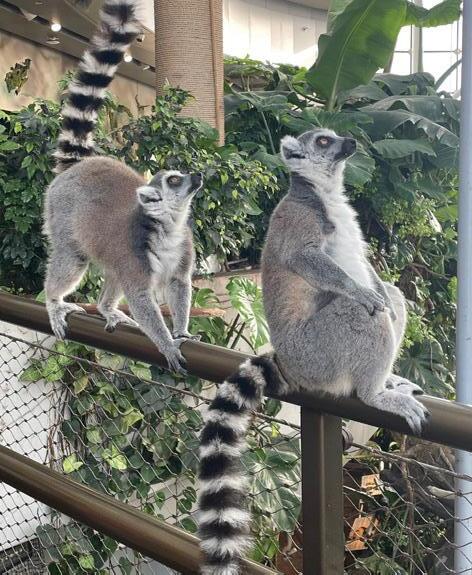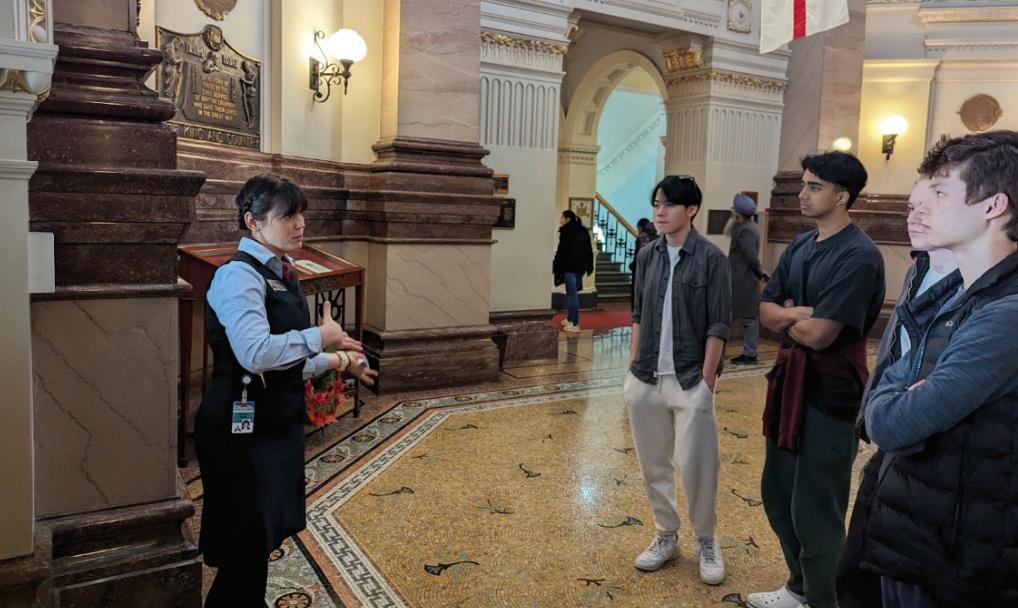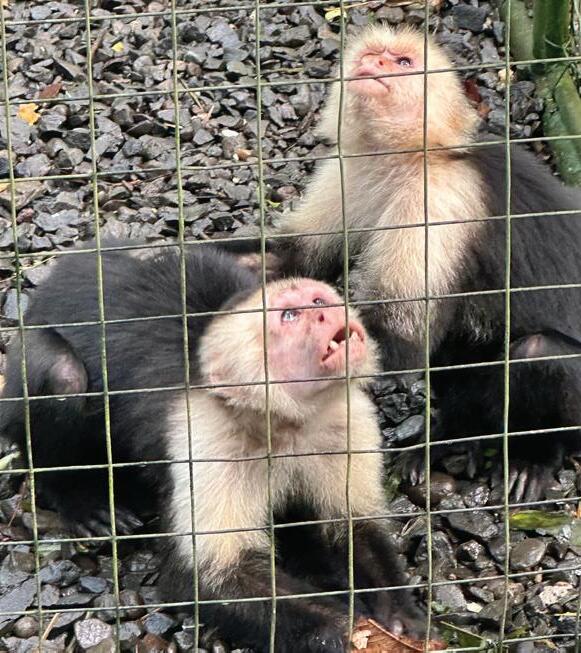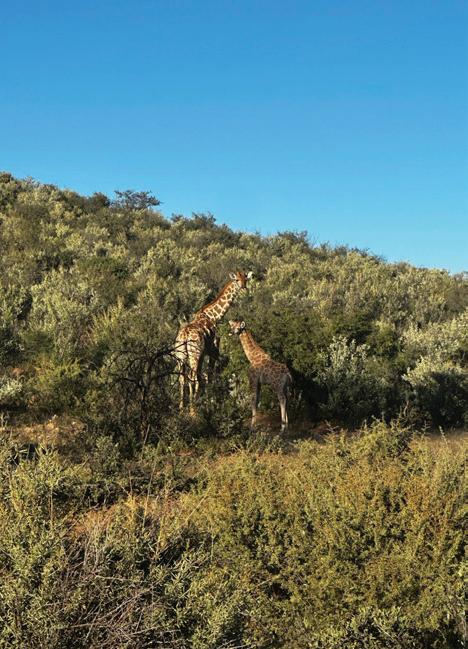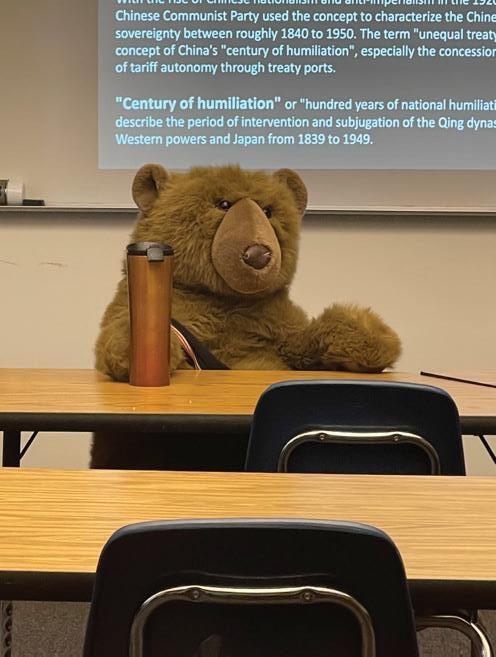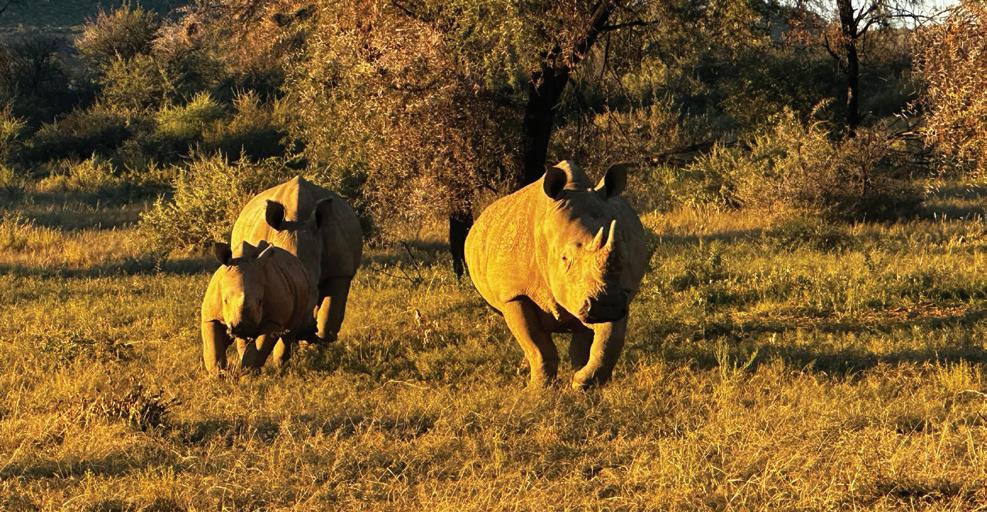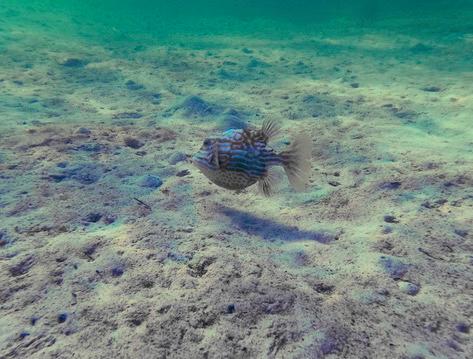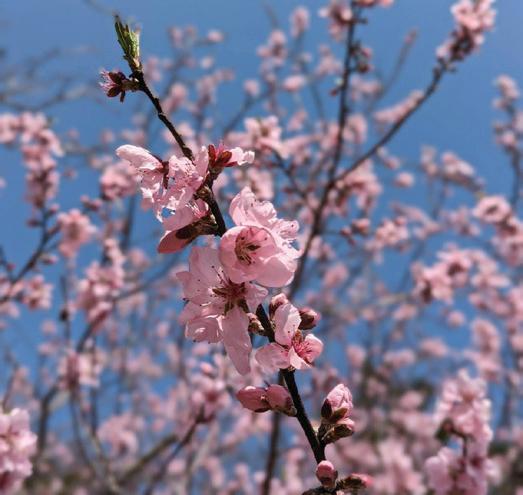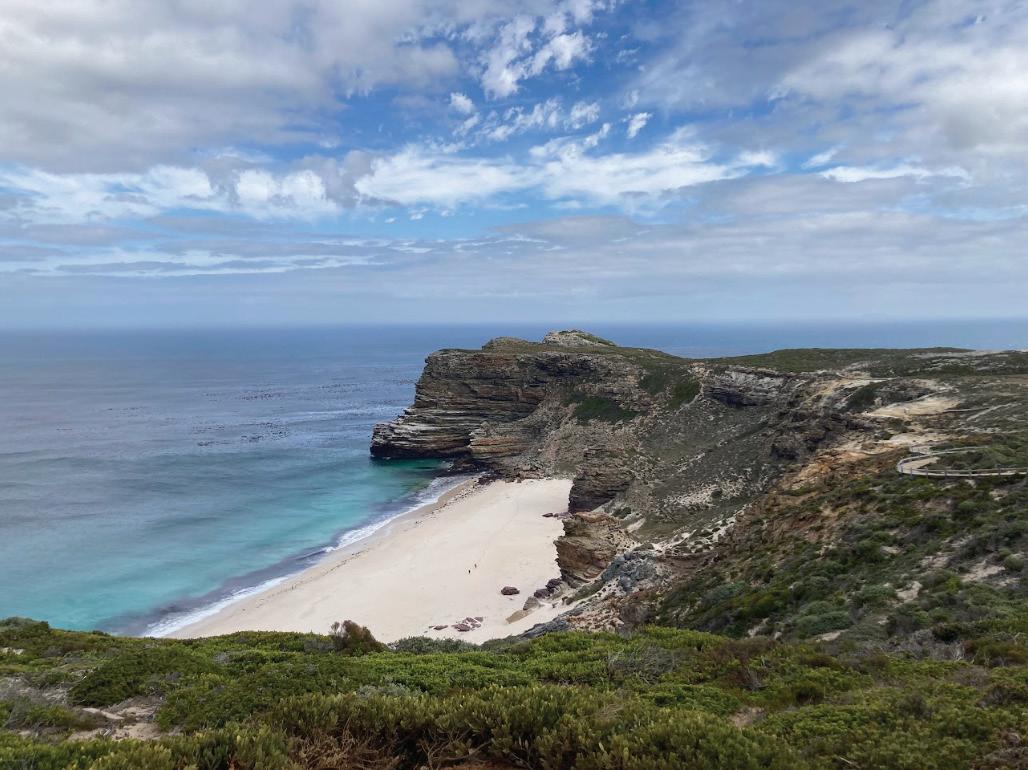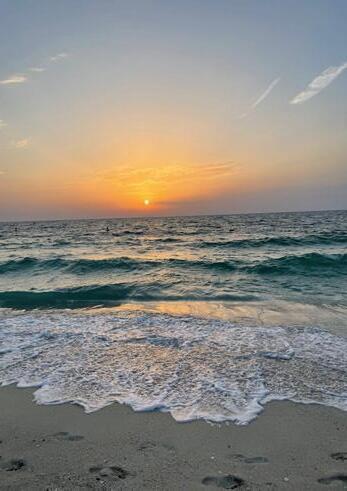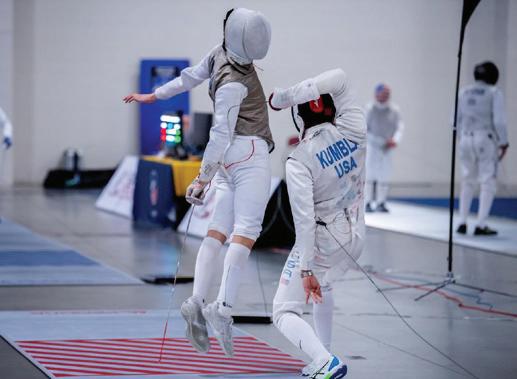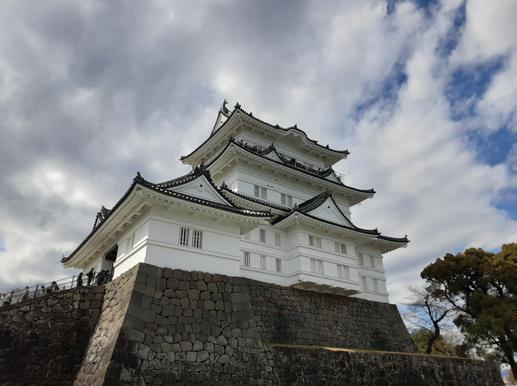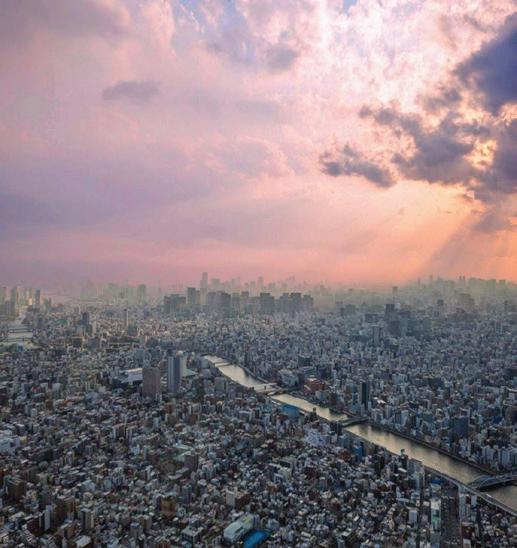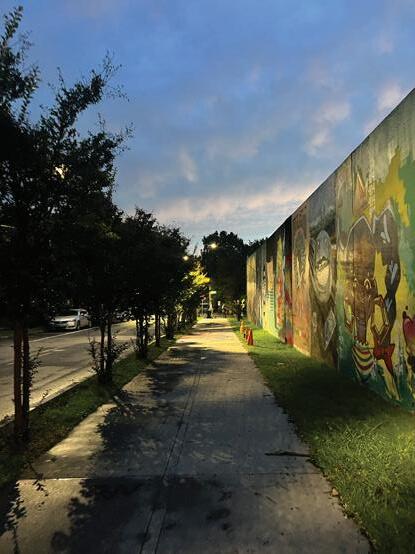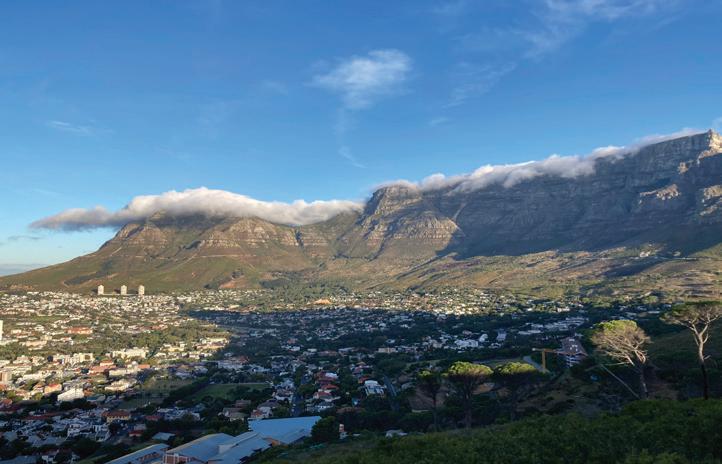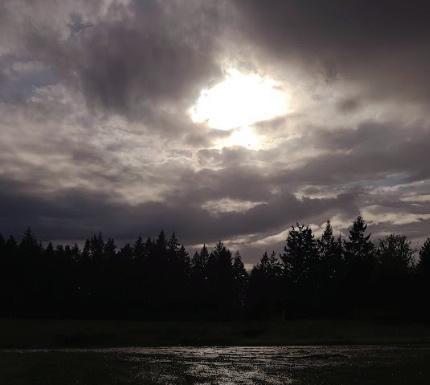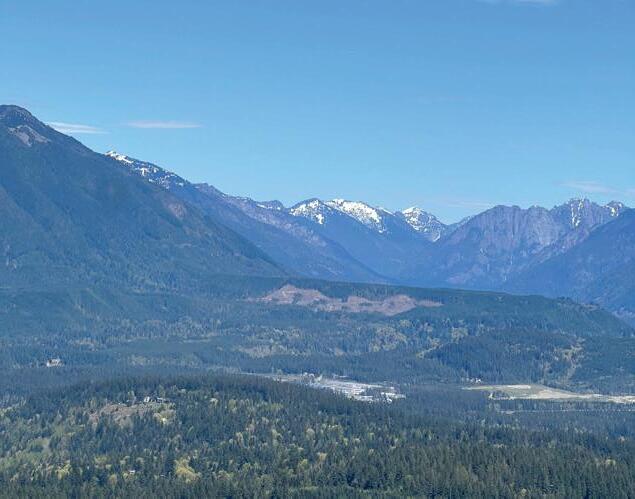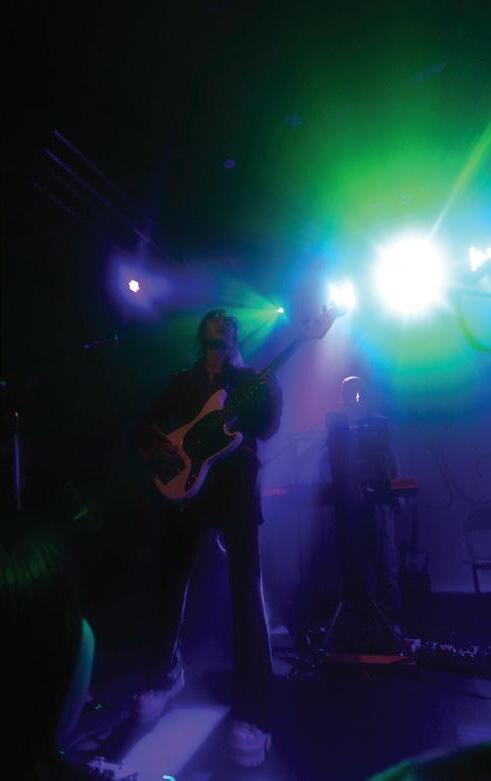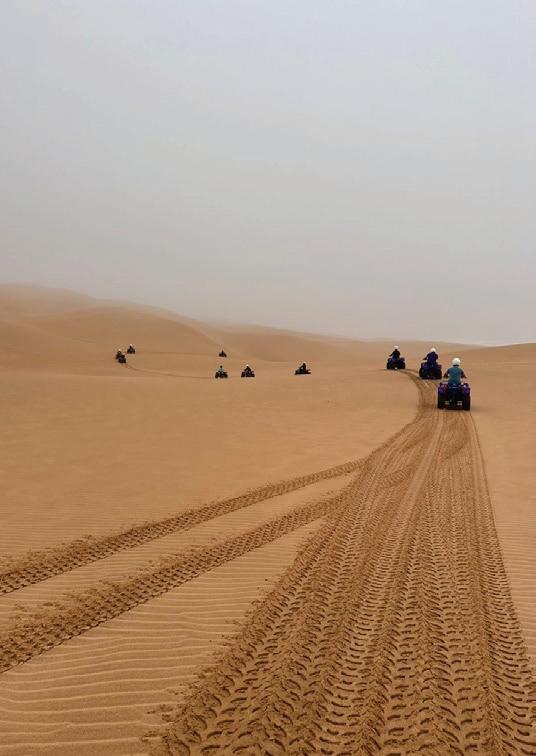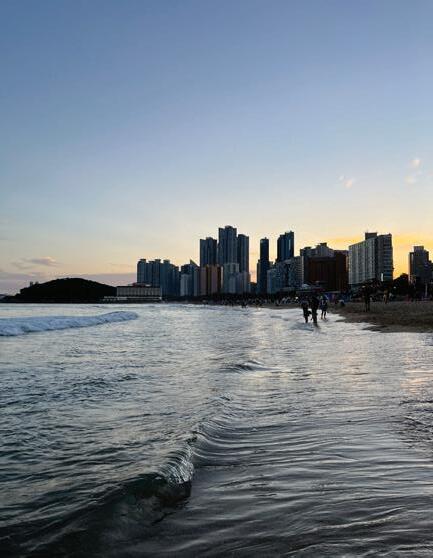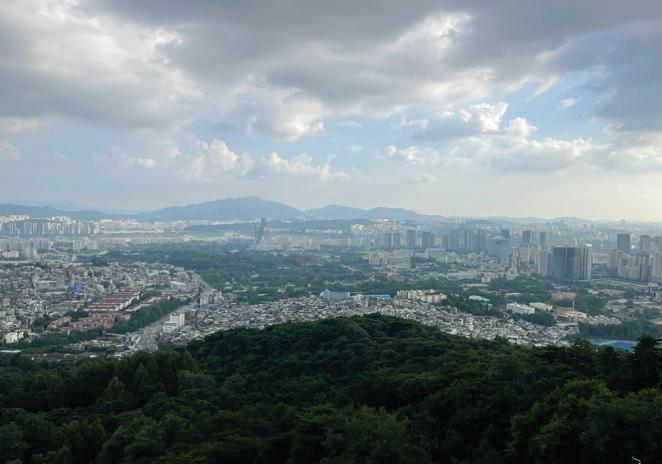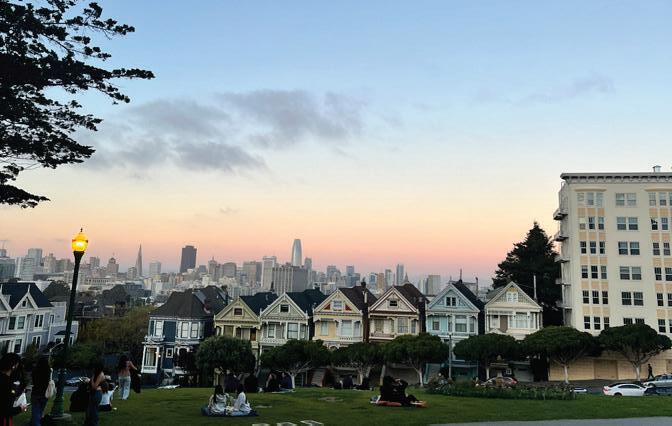INKWELL
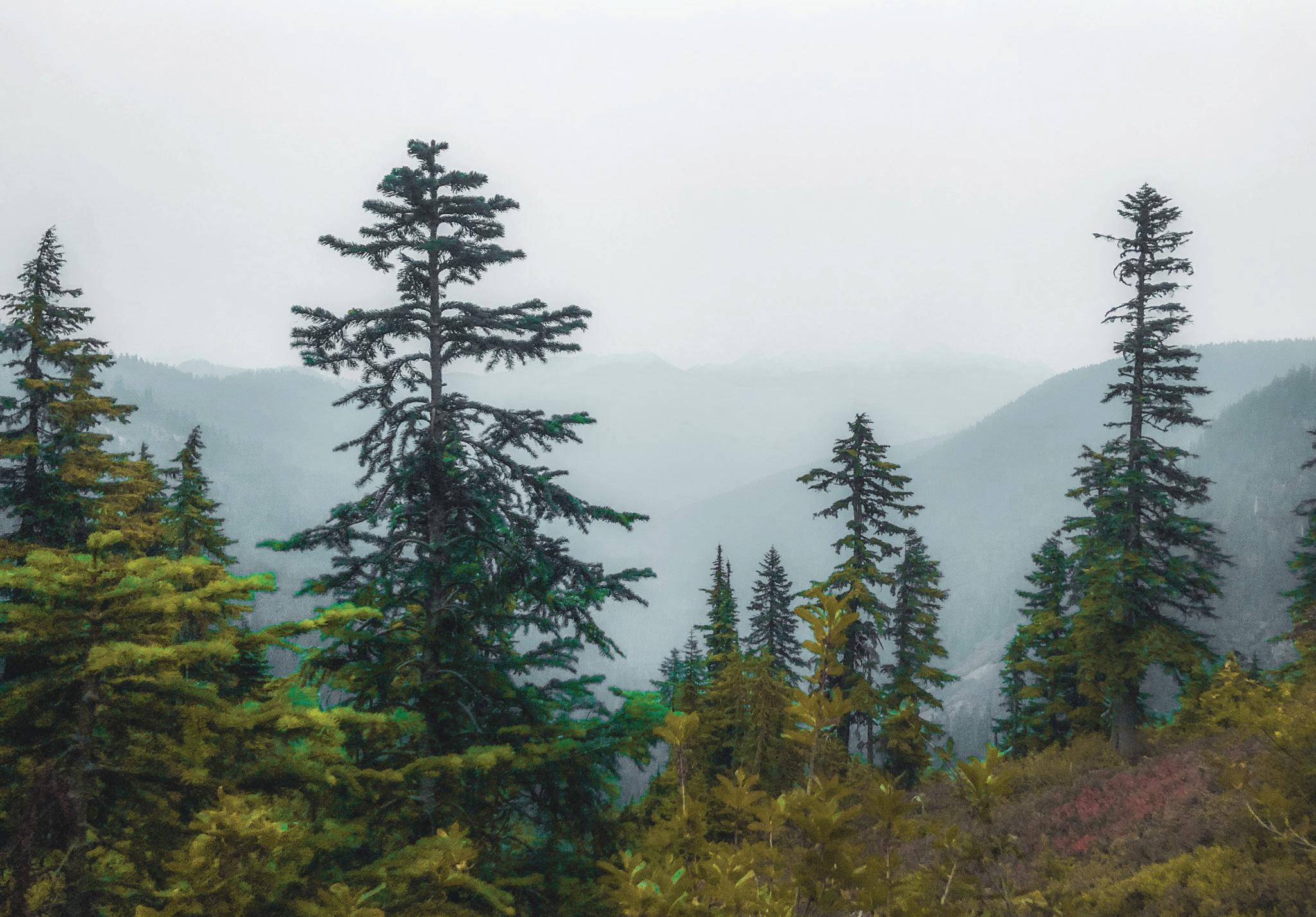
LETTERS FROM THE EDITORS
Hey! For our last issue of the year, Inkwell wanted to make an issue incorporating travel as the Upper School has gotten to embark on many adventures this past year and we wanted to make an issue featuring all the corners of the world us at Annie Wright have gotten to experience!
We are also very excited to enter into a new phase of Inkwell as this issue also signifies the change of co-editorin-chief from Amelia Hermann-Scholbe to Ellis Giller. Working with Amelia has been a joy this year, watching her balance senior year, shining in her sports, and editing for Inkwell has been a gift and we wish her nothing but the best!!!
We hope you all enjoy, thank you for reading!
- Lucy Hall
STAFF
Hey everyone! I am so excited to step into the editor role for this issue and for next year. In closing out this school year, we wanted to focus on a more global theme that recognizes the international aspect of our school. This issue is titled, ‘Where in the World” and includes visual and written representations of a wide variety of places, traditions, music, and art. We also highlighted the different trips and experiences that occurred throughout this school year. I hope what resonates with you after you’ve finished reading this issue is how truly global our school is. Thank you for reading!!
- Ellis Giller
Lucy Hall - Editor & Articles
Ellis Giller - Editor & Articles
Ireland Jean - Design editor & Articles
Jamie Archer - Teacher lead
Meher Bahia - Articles
Sarah Wang - Articles
TT Nguyen - Articles
Minh Nguyen - Articles and photos
Hey Inkwell readers, hopefully you find this issue both engaging and fun to look at. As design editor my goal is to create a visually pleasing and efficient design. Putting this issue together has been full of ups and downs. Putting all the wonderful articles, photos, and reviews together has been an honor and getting to make sure everybody who worked so hard on their contributions gets the credit they deserve. So thank you for taking some time out of your day and picking up this issue to appreciate all the wonderful work I and the other staff members have done. Hope you enjoy it!
- Ireland Jean
Peyton Mathews - Articles
Eisha Ahmad - Articles
Jack Cushman- Articles
Jerimiaha Harshman - Articles
Flora Hu - Articles
S O L A R G E O E N G I N E E R I N G
An opinion piece by Ellis Giller
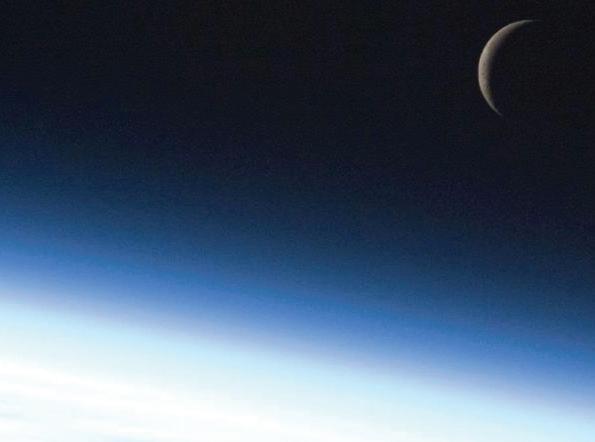
PREFACE:
Upon researching various solutions to climate change, I came across a solution called geoengineering. The more I learned about it, the more I became concerned about the potential consequences. This is an opinion piece on the negative effects of solar geoengineering and how it’s not the ‘climate change solution’ people are claiming it is.
The outer atmosphere of Earth captured by NASA https://education.nationalgeographic.orgresource/parts-atmosphere/
In light of the climate crisis, many different solutions are being considered and suggested. One of these proposed solutions is solar geoengineering. As CNN’s environmental and social inequity journalist, Laura Paddison, puts it, “At its simplest, solar geoengineering, also known as solar radiation management, is an attempt to bring down the planet’s temperature by reflecting sunlight away or allowing more heat to escape into space” (Paddison 2023). This is done by spraying aerosol particles into different kinds of clouds in order to thin them out or make them more reflective. Solar geoengineering aims to temporarily or permanently reduce the temperature of the planet; however, it comes with a set of
significant concerns. Geoengineering has potential large-scale consequences that could severely affect or destroy lives. Solar geoengineering could also distract and draw investments from other more promising solutions to address the climate crisis, and create a sense of false hope that manipulating the Earth’s atmosphere is the “silver bullet” solution to the challenge. Additionally, it is impossible for solar geoengineering to be governed justly and equitably, given the current power imbalances of the world. The risks and impacts of solar geoengineering are too great to consider this technology as a viable solution to climate change.
Solar geoengineering has drastic potential consequences that could permanently alter ecosystems, environments, and each individual life on this planet. Scientists can hypothesize the worst-case scenario, but the reality is, there is no clear answer to what might actually happen if solar geoengineering were initiated at a large scale. Dr. Ben Kravitz, an atmospheric scientist from the Pacific Northwest National Laboratory, researched the possible effects of solar geoengineering and stated, “Despite recent research, it is still very difficult to gauge what the true impacts of using aerosols to cool the planet would be’’ (Kravitz 2018). He concluded that scientists would need to research and experiment for much longer before it would be truly safe to allow solar geoengineering. Professor Alan Robock, who teaches in the department of environmental sciences at Rutgers University, has identified a problem with the current aerosol technology, “Even if you could, what do you spray? Do you spray sulfur dioxide gas? When the sulfur comes down, it’s going to create acid rain” (Robock 2018). Even if scientists figure out how to successfully release aerosols into the air, they currently don’t have the right materials to make the aerosols without creating harmful after effects. Scientists have also researched the consequences of a rapid rise in global temperatures, causing “termination shock.” Raymond Pierrehumburt, a Oxford University physics professor, told CNN, “As the aerosol particles do not tend to remain in the atmosphere for more than about a year, solar geoengineering would have to be continuously maintained. It would have to be continued without fail year after year, for 1,000 years or more — lest the termination shock from cessation of the intervention unleash pent-up global warming that would fry the planet in a matter of decades”(Pierrehumbert 2023). Essentially, solar geoengineering would only delay the effects of warming, and the technology would have to be in constant use for many generations to withhold the heat for a significant amount of time. If solar geoengineering wasn’t maintained for 1,000 years or more, then the abrupt change to higher temperatures would have catastrophic effects on biodiversity. Solar geoengineering has too many potential negative consequences to be used to tackle climate change. Solar geoengineering is also a major distraction from other already existing solutions to climate change that have far fewer negative consequences. For example, solar and wind technologies, which are plummeting in price, produce electricity without releasing greenhouse gasses. New tools to sequester carbon are also emerging while more established techniques like planting trees and practicing regenerative agriculture are gaining momentum.
At last, the urgency of climate change is catching on, and it’s important not to distract from the current sense of crisis. Professor Govindasamy Bala of the Divecha Centre for Climate Change at the Indian Institute of Science has researched people’s reactions to hearing about solar geoengineering. He stated, “People might think [geoengineering] is a solution to climate change and, hence, abandon the efforts in CO2 emission reduction. This might allow CO2 to build to dangerous levels in the atmosphere by the end of this century” (Bala 2018). Solar geoengineering might make big changes quickly, but it could discourage or lessen people’s and politician’s desire to change more substantively the ways humans have been generating and using energy. Solar geoengineering might also continue our reliance on fossil fuels. Frank Biermann, a political scientist at Utrecht University, affirmed this point, “Soon everyone who is dependent on coal, oil and gas will jump on the solar engineering bandwagon and say, ‘We can continue for 40 years with fossil fuels’…this debate threatens to derail current climate policies. It’s a huge risk” (Biermann 2023). The world is so dependent on fossil fuels, that it would be easy for people to use solar engineering as an excuse to continue taking advantage of fossil fuel and stop the momentum that is currently going to become electric. That’s just another example of how solar geoengineering could distract from the climate crisis and allow people to continue with an energy system that is harming our planet.
Lastly, solar geoengineering would stem from inequality of power and could lead to serious conflict among countries. As the current world is so unbalanced in power and control, solar geoengineering would be just another way for powerful countries to take advantage of smaller or poorer ones. Jennie Stephens, a professor of sustainability science and policy at Northeastern University stated, solar geoengineering, “...can never be governed in a fair and equitable way given global power imbalances’ ‘ (Stephens 2023). Solar geoengineering would impact the lives of every living being, yet decisions related to its use would be controlled solely by the most powerful, wealthy countries. With the usage of the United Nations decision making process, it is possible that by the time every single country in the world agreed on how solar geoengineering should be managed, the climate crisis might already have reached a point of no return. Elizabeth Chalecki, a professor of political science at University of Nebraska Omaha, said in a recent Washington Post article, “You can’t even govern based on carbon emissions. How are you going to govern a technology that could purposefully
alter planetary living conditions?” (Chalecki 2023).How is the whole world going to agree on blocking the sun if the United States itself hasn’t been able to reach a consensus on eliminating carbon emissions. It would be very challenging for countries around the world, especially ones that have existing friction, to come to a consensus around a technology that impacts weather and the planet’s biodiversity. Malik Amin Aslam, a former Pakistani minister for climate change, talks about his own experience navigating relations between Pakistan and India. “In troubled neighborhoods like ours, the protocols of the [geoengineering] trials will need to be coordinated and collectively monitored, which becomes an impossibility in the highly fractured and polarized environments like the one that exists between Pakistan and India” (Aslam 2023). Without proper governance and control, solar geoengineering could lead to war between countries. As highlighted by Aslam, Pakistan and India are already critically polarized in their viewpoints Ajay K. Hood, the principal scientific adviser to the Indian government, talked about how controversial solar geoengineering would be: “Solar geoengineering has potential social and ethical issues around public consent and has the potential to spawn international conflicts” (Sood 2023). Solar geoengineering will always be controversial, and it would be nearly impossible for it to not be controlled primarily by the most powerful countries. One could say that any climate change solution will be controversial, but solar geoengineering isn’t just controversial: it has the potential to completely destroy places that might not have even agreed to use it in the first place. As global warming escalates, every proposed solution must be considered which is why the idea of solar engineering has been widely considered. However, the negative consequences that could ensue might lead to the extinction of entire species. Additionally, solar geoengineering would serve as a distraction and false hope, causing countries to stop their progress in reducing carbon emissions. If the technology wasn’t maintained in the future, all the heat prevented by solar geoengineering would be released back into the Earth’s atmosphere. Given the current state of the world, it’s unlikely that the world’s countries could design an equitable and fair process to agree on how solar geoengineering would be governed. Smaller and poorer countries would, once again, get pushed around by larger, more powerful ones, and countries that already have conflict might end up in a serious war. The potential downsides that have already been discovered are too great to instigate solar geoengineering as a significant climate change solution. More viable solutions already exist, with other promising ones emerging at a quick pace; this is where the focus and faith should be in addressing the global crisis of climate change.


https://votesolar.org/


https://kc3.nyc/our-story
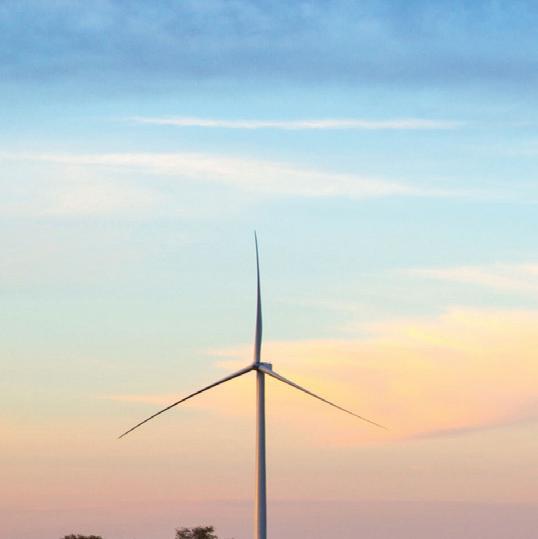

https://www.enelgreenpower.com/learning-hub/
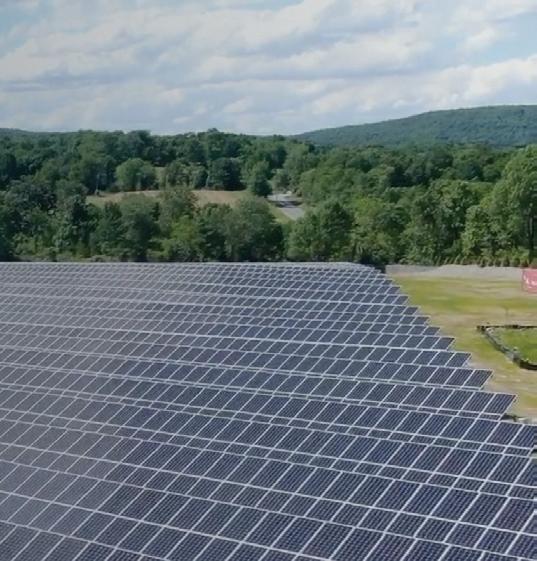

https://solstice.us/
Paddison, Laura. “This Controversial Climate Solution Could Be Exactly What the Planet Needs. or It Could Be a Colossal Disaster.” CNN, 12 Feb. 2023, www.cnn.com/2023/02/12/world/solar-dimming-geoengineering-climate-solution-intl/ index.html.
Bokat-lindell, Spencer. “Should We Block the Sun to Counter Climate Change?” The New York Times, 11 Jan. 2023, www. nytimes.com/2023/01/11/opinion/geoengineering-climate-change-solar.html.
Temple, James. “This Technology Could Alter the Entire Planet. These Groups Want Every Nation to Have a Say.” MIT Technology Review, 17 Apr. 2023, www.technologyreview.com/2023/04/17/1071654/this-technology-could-alter-the-entire-planet-these-groups-want-every-nation-to-have-a-say/.
Harrisson, Thomas. “Explainer: Six Ideas to Limit Global Warming with Solar Geoengineering.” Carbon Brief, 27 Feb. 2019, www.carbonbrief.org/explainer-six-ideas-to-limit-global-warming-with-solar-geoengineering/.
Trisos, Christopher H., et al. “Potentially Dangerous Consequences for Biodiversity of Solar Geoengineering Implementation and Termination.” Nature News, 22 Jan. 2018, www.nature.com/articles/s41559-017-0431-0#auth-Alan-Robock. “A ‘Climate Solution’ That Spies Worry Could Trigger War.” The Washington Post, 27 Feb. 2023, www.washingtonpost. com/climate-environment/2023/02/27/geoengineering-security-war/.
CONCERT REVIEWS
On October 28th, the indie rock group Duster played at Showbox Theatre in Seattle. Going into this concert, I wasn’t entirely sure what to expect and went into the event with the assumption that people would either be shoegazing or starfished out on the floor. However, none of my assumptions accurately prepared me for the crowd; the diversity of concert goers at this show was incredible. One of the first people I saw coming into the concert was a younger adult watching a football game on his phone with his airpods in. The kid looked like someone had dragged him into the show and forced him into the pit. But even this football-preferring alleged Duster fan surprised me, the split split second the group started to play he fully got into the music swinging his head up and down and jumping wildly around.
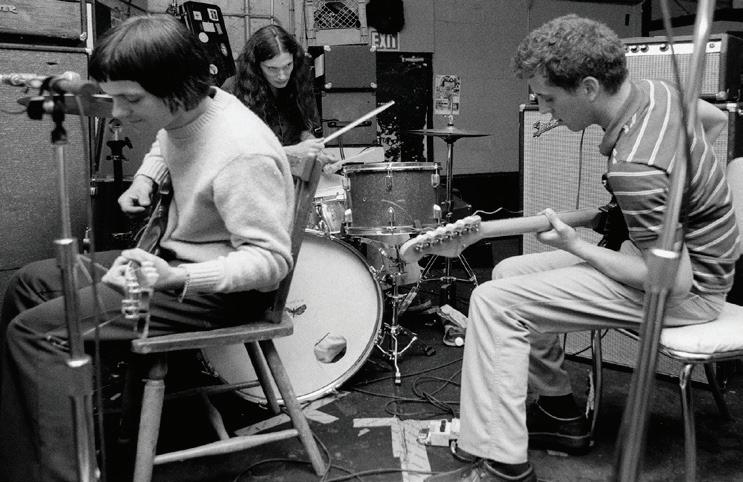
DUSTER
by: Lucy Hall
Duster is an indie rock/slowcore group, if you’ve heard any of their music, you know the slow, melancholy feel it evokes. So I was a bit taken aback when the crowd split, leaving a circle in the middle and the mosh began. The energy and atmosphere of the crowd went from reflexive and borderline sad to harsh, and violent, but simultaneously fun.

There were a few moments in which the intensity grew beyond what the theatre was ready for. My friend ended up getting socked in the face, which, ironically, is what made us join the mosh and was what ended up laughing the most about afterwards. There were, of course, a few fights, but everything eventually simmered down to the typical rock energy and excitement. Throughout all of this, the gentle voices and loud pluck of guitars carried an electric energy throughout the room that made people feel even more alive. Randomly enough, there was a point in the middle where my entire face was on a stranger’s shoulders getting shoved further into the man’s back before the mosh switched direction. When the crowd broke apart, the image of the disheveled-looking man still sans shirt leaving to go home was our last picture of the night. Even upon the groups departure the energy conjured during the show stayed with a continued buzz filling the room from the fun of the performance.
SUNROOM
by: Lucy Hall
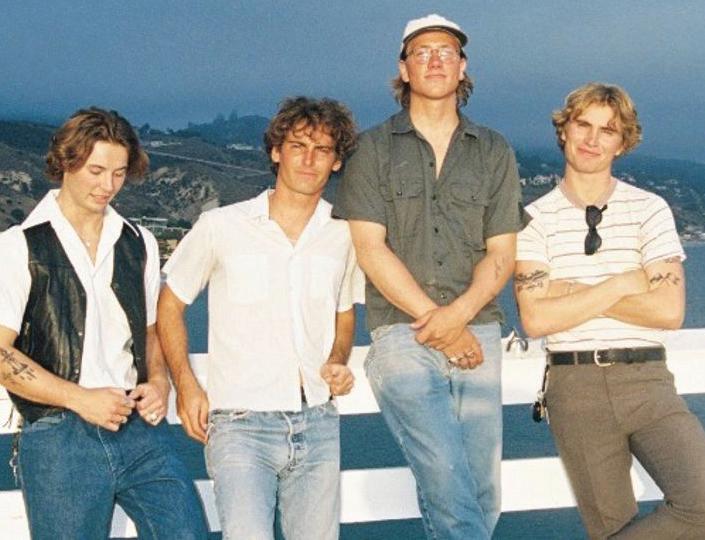
Thursday, November 14th, Neumos Theatre in Seattle hosted the surf rock groups Sun Room and Surf Trash. The band Surf Trash is a small rock group consisting of three guys from Australia, their nationality was overemphasized as a sort of selling point. While I am all for promoting your home country, this felt to me like a pathetic attempt to capitalize on Australian stereotypes and milk their accents to excite a specific demographic in the crowd and promote their music. It almost felt like a cheap attempt to win over a few new fans, but I honestly don’t think it was necessary because their music is quite enjoyable on its own.
FAYE WEBSTER
by: Peyton Mathews
Throughout their performance which included lots of bass, flashing lights, and high energy from the group, the crowd remained pretty still with no real dancing or energy. The show lasted about an hour and throughout this time there was no change in the energy or notable growth in excitement. Finally, Sunroom began their set and I quickly realized that the energy given to the opener’s performance had set the tone for the entire night. The music itself was super danceable, had good energy, and good guitar solos. Watching all four members of the band get into their songs and relax into the performance throughout the night was a joy.
On November 2nd the rope lights of Showbox Sodo lit up for the many fans anxiously awaiting to listen to Faye Webster live. This was her second time back in Seattle, the first a little less than 4 years ago. Showbox Sodo was her 10th stop in her “I Know I’m Funny haha” tour, an album she released in 2021.
Her arrival had people waiting over eight hours in the cold Seattle weather to see her up close. Once they opened the doors fans of all ages rushed to the front of the stage, excitedly anticipating that in the next 2 hours she would be in front of them.
Throughout Sunrooms’ performance, my friend and I danced, screamed, and sang at the top of our lungs, but alas, this didn’t encourage any of our surrounding crowd to do the same. There were a few attempts at a mosh pit, but the number of people into it was so few that nothing came of it. Overall, the group itself was a delight to see live, but their energy was not at all matched by the crowd. Nevertheless, Sunroom brought an amazingly bright and joyous energy to the rainy Washington day they and the crowd were stuck in.

https://chasingthelightart.com/rock-sun-room/
Once the show started the crowd went silent, everyone listened to her play the guitar for her opening song “But Not Kiss”. Faye played a variety of newer and older songs, making sure she played all the favorites but also including some fun original tunes. The energy was electric, people dancing and singing. Everyone was having a wonderful time at her show.

https://www.fayewebster.com/
https://www.jambase.com/show/faye-webster-the-lowbrow-palace-20240921

EARL SWEATSHIRT
by: Peyton Mathews
Earl sweatshirt performed at Showbox Sodo in the beginning of November, the crowd wrapped around the block for his first show of the tour. The venue was packed more full than I have ever seen it, more than any other artist.
People were squished to the walls and sitting on people’s shoulders just to get a view of the man on that stage. As we were being pushed and pulled in the dense crowd, the only air you could find was by looking up to the ceiling. He played mostly songs off of his new album “VOIR DIRE’’ while also including some new freestyle raps.

This show was different then shows I normally see, it wasn’t just a performance. Up there with The Alchemist, they were bouncing off each other and creating true art. Concerts are a place for all ages, whether you are 15 or 50, you are there for the music, and Earl Sweatshirt delivered.
DIYET OF LOVE AND SOLDIERS
by: Lucy Hall
Upon closing your eyes, it is difficult to not be lulled into a blissful peace that is only heightened by the raw and enchanting vocals projected from the tall wooden beams of the auditorium. In March of this year, Diyet and the Love Soldiers put on a performance at University of Victoria, the alma mater of Diyet herself.
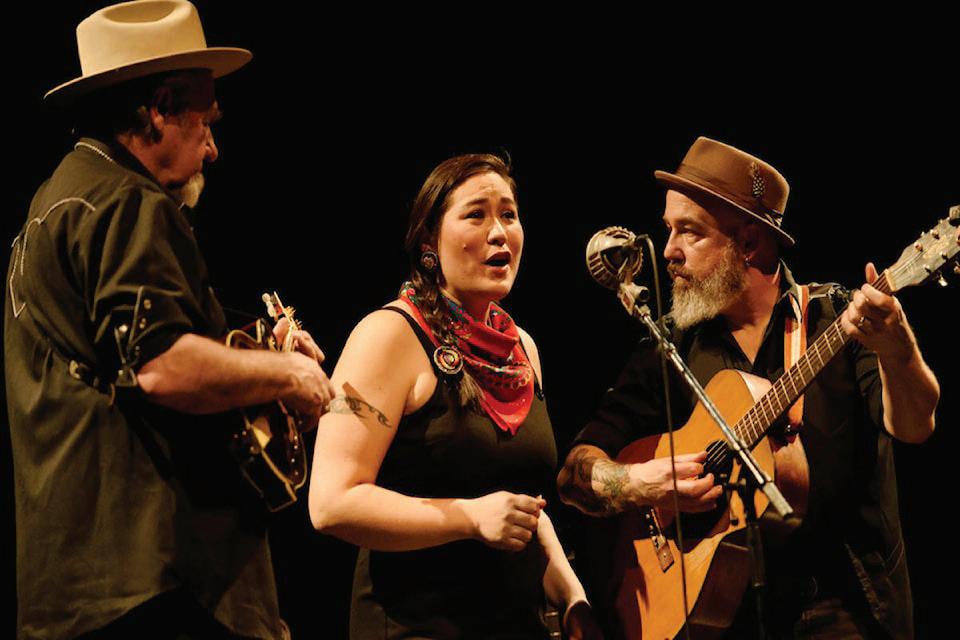
Preceding the performance of most of their songs, Diyet would share the influences of her writing. The brilliance of Diyets artist not only lies in her incredibly soulful vocals, but also in her writing. In her music, Diyet finds a way to poetically address the grief she and countless others have gone through due to the usurpation of their land while simultaneously capturing the fulfillment she receives from the land and all it provides for Diyet and her tribe.
In her song “We’re still here”, Diyet writes, “They keep trying to take my flowers and replace them with guns”, addressing how people are attempting to steal her peace along with the geographical resources the land has to give In her song “Ä’sía Keyi”, Diyet sings in Southern Tutchone, and the name of the song, directly translated, means s “Grandfather’s Land.” Through this ballad, Diyet laments the loss of having her native land once stripped from her and her people and rejoices in the fulfillment her current relationship with the land brings her. The night ended with the entire room standing and singing along with Diyet as she gracefully guided her audience into joining her last song.




“We’re Still Here” “Ä’sía Keyi” “Grandfather’s Land.” “Like a Drum”

BACKPACKING ON THE OLYMPIC COAST
By: Ireland Jean
Annie Wright is a school rich with many varied opportunities, one of these GOAT(great outdoor adventure team). This program works to give students of all skill levels the opportunity to get outdoors and get the most out of our beautiful and ecologically diverse corner of the United States. I joined GOAT at the beginning of this year and have unfortunately missed out on trips due to conflicts. But most recently I was able to attend my first trip. As a student instructor, I helped all the other participants who were new to backpacking get a hang of how to be outdoors. We spent three days and two nights roaming through temperate rainforests and along the Olympic coast with its panoramic views of the Pacific ocean with beautiful sea stacks and wildlife. The weather started out with unusual yet welcomed sunshine then moved into constant, yet unbothersome, rain, which I would consider a more authentic experience of the Pacific Northwest.
I can easily say that this trip did not disappoint. I was there with Jeff Barber, Carie Ward, and Betta Hanson, who did an immense amount of well thought out preparation for the trip that immensly helped everyone be ready and comfortable. The other students that went were, Xin (Kevin) Tong, Runzhe (Henry) He, Zhengan (David) Chen, Zongye (Thomas) Han, and Sophie Nguyen. It was wonderful getting to know all of them through the three days that we spent on the Olympic coast. During our hike of the Ozette triangle we saw a varying array of wildlife, ranging between an adolescent black bear, banana slugs on the trail, bald eagles and hawks perching on the sea stacks, Sandpipers running up and down the beach, and a multitude of crabs on the shoreline. I look forward to further GOAT outings because it is an easy way to get out and enjoy the natural beauty that Washington provides.
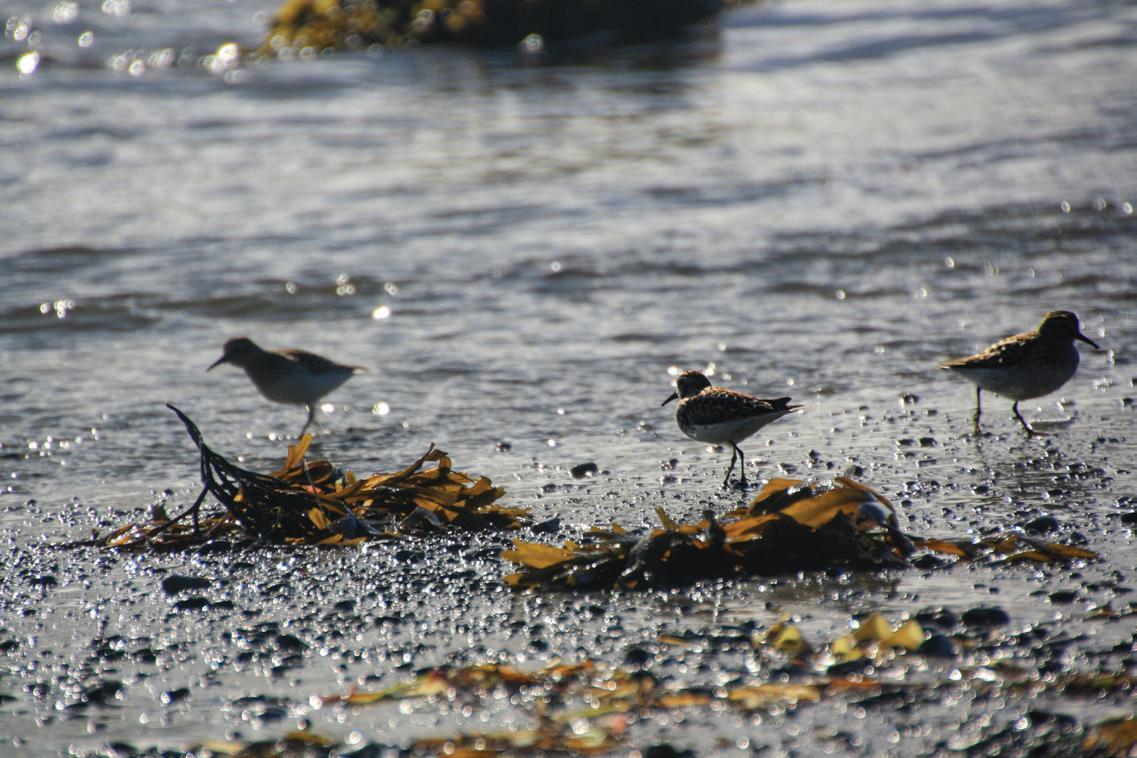
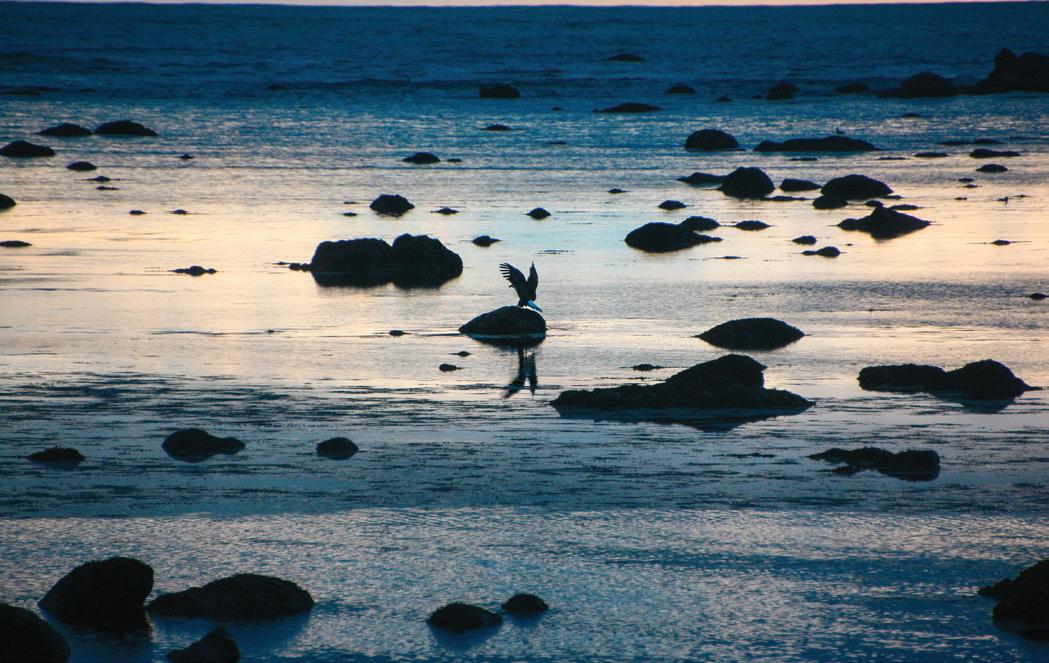
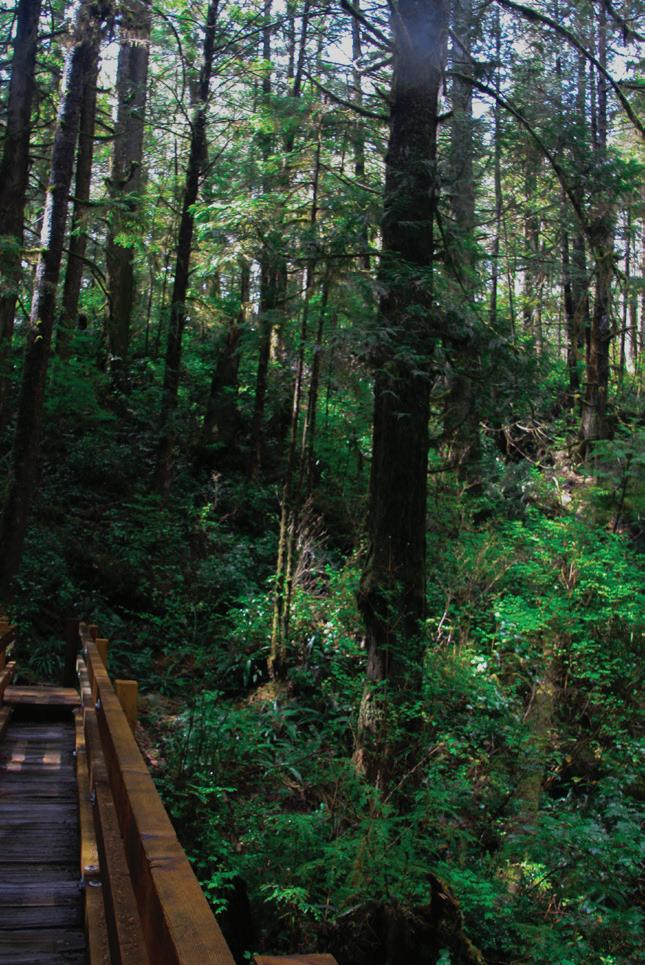
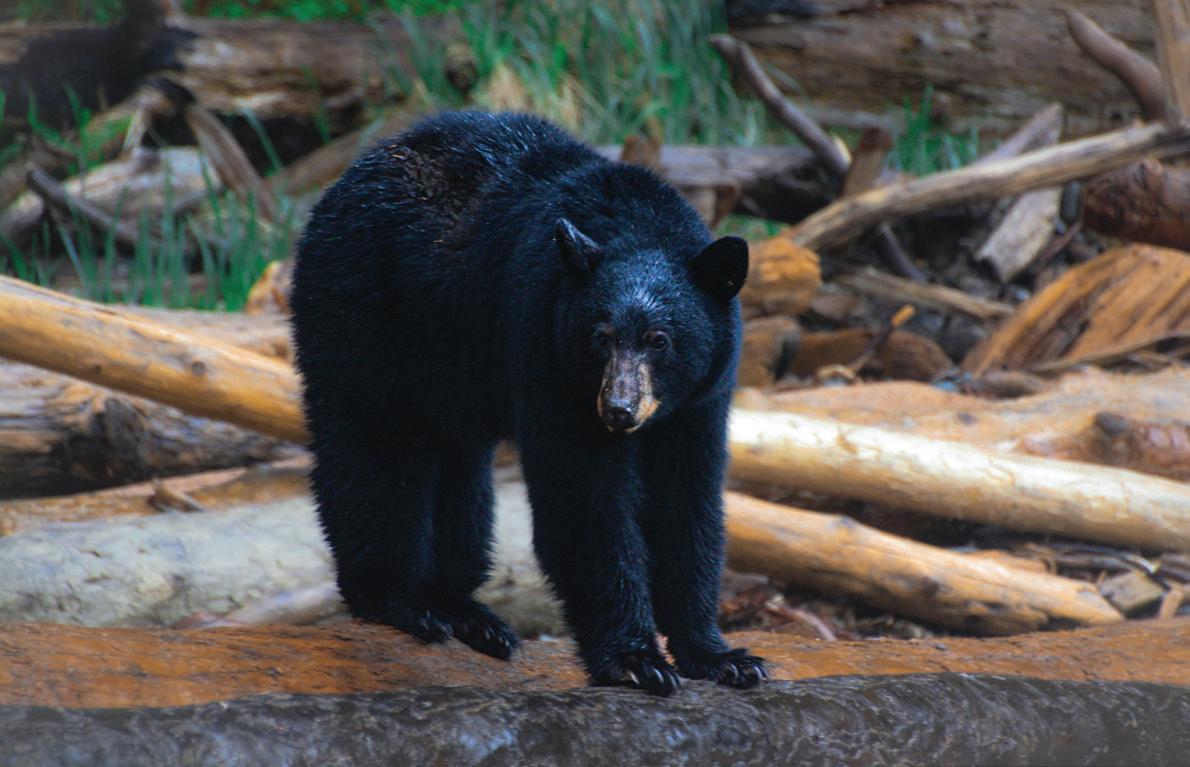
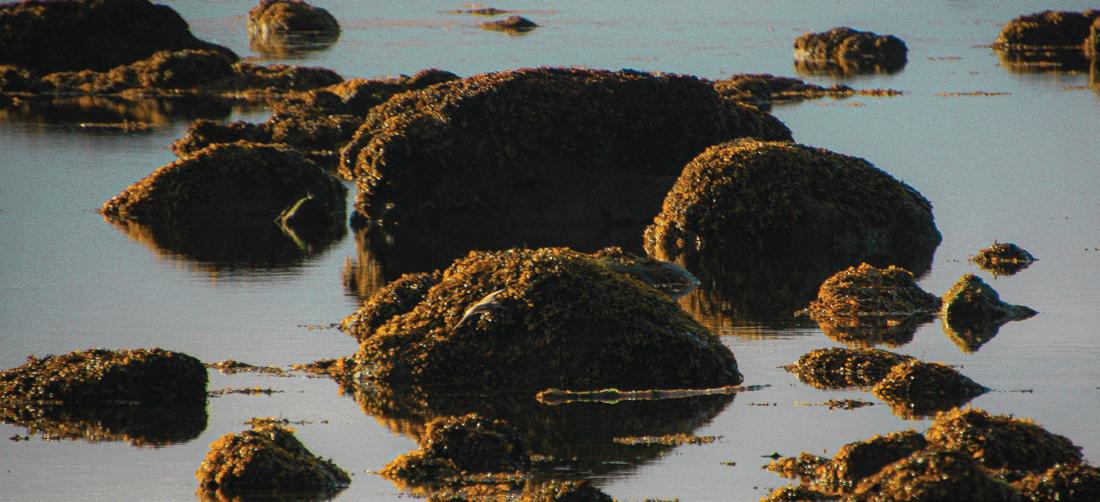
PLAY LISTS INKWELL HAPPY PLAYLIST

BIPOC MARKET
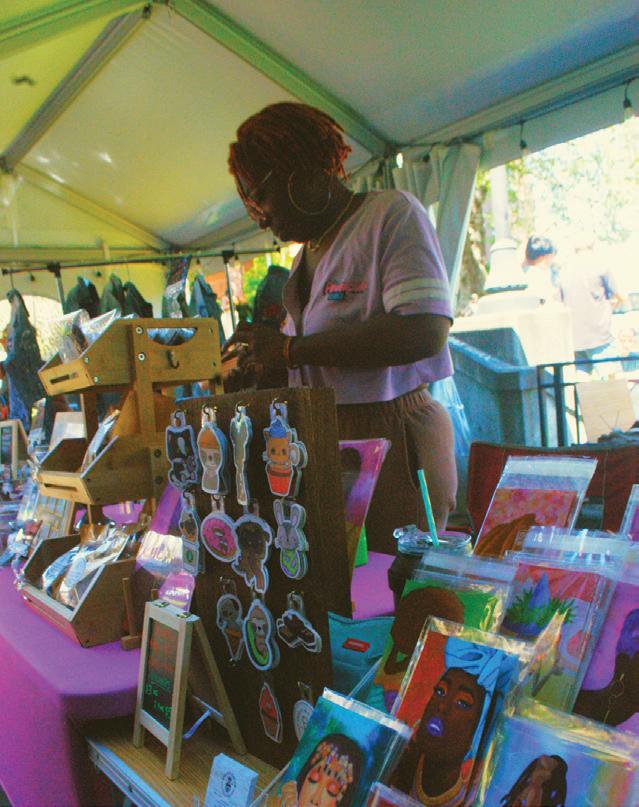
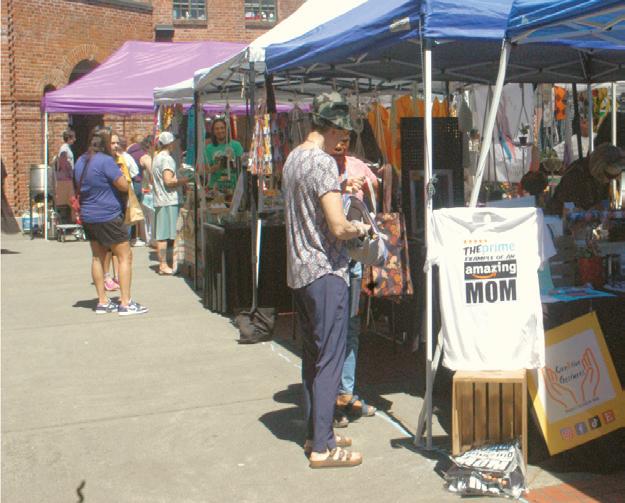
From TT Nguyen
By:Eisha Ahmad
by Minh Nguyen
Over 70 vendors attended the BIPoC market on May 11 this year, a record for the Community (s)Elective! Delicious cuisine from the Philippines to Mexico to savory American Burgers and ice cream were available for all to enjoy. Booths offered candy and crafts from Indigenous cultures to many POC clothing, jewelry, pottery, books and self care goods providing options for any consumer. This year’s market definitely helped small local businesses get more representation in our community through Annie Wright. There was not only representation from underground businesses but also for the culture of black, indigenous and other people of color groups as many native Indigenous dances were performed as well.
Make sure to stop by for the 2025 BiPOC Market next year too!
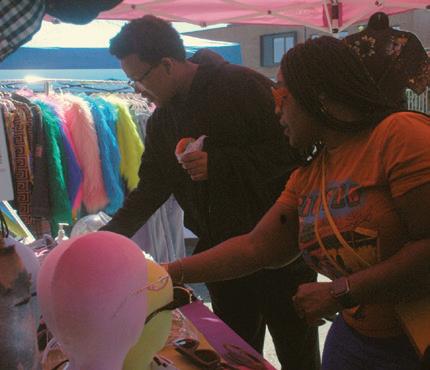
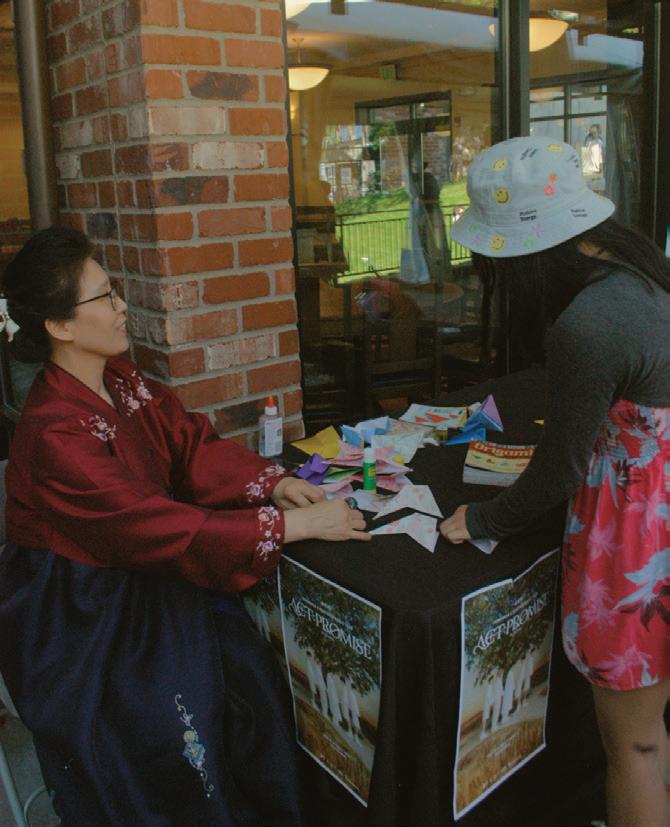
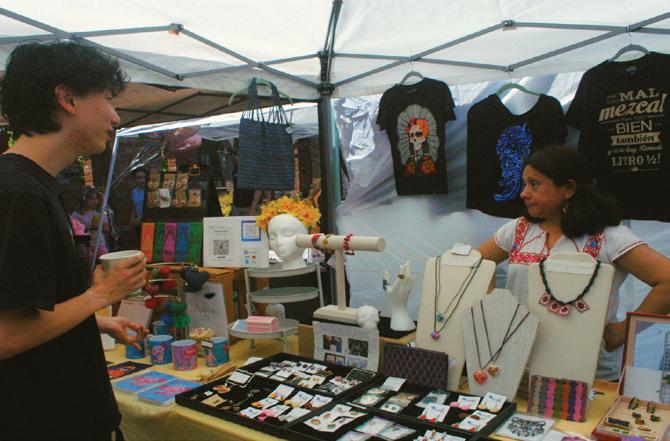
Hidden Temples Amid Evergreen Forests
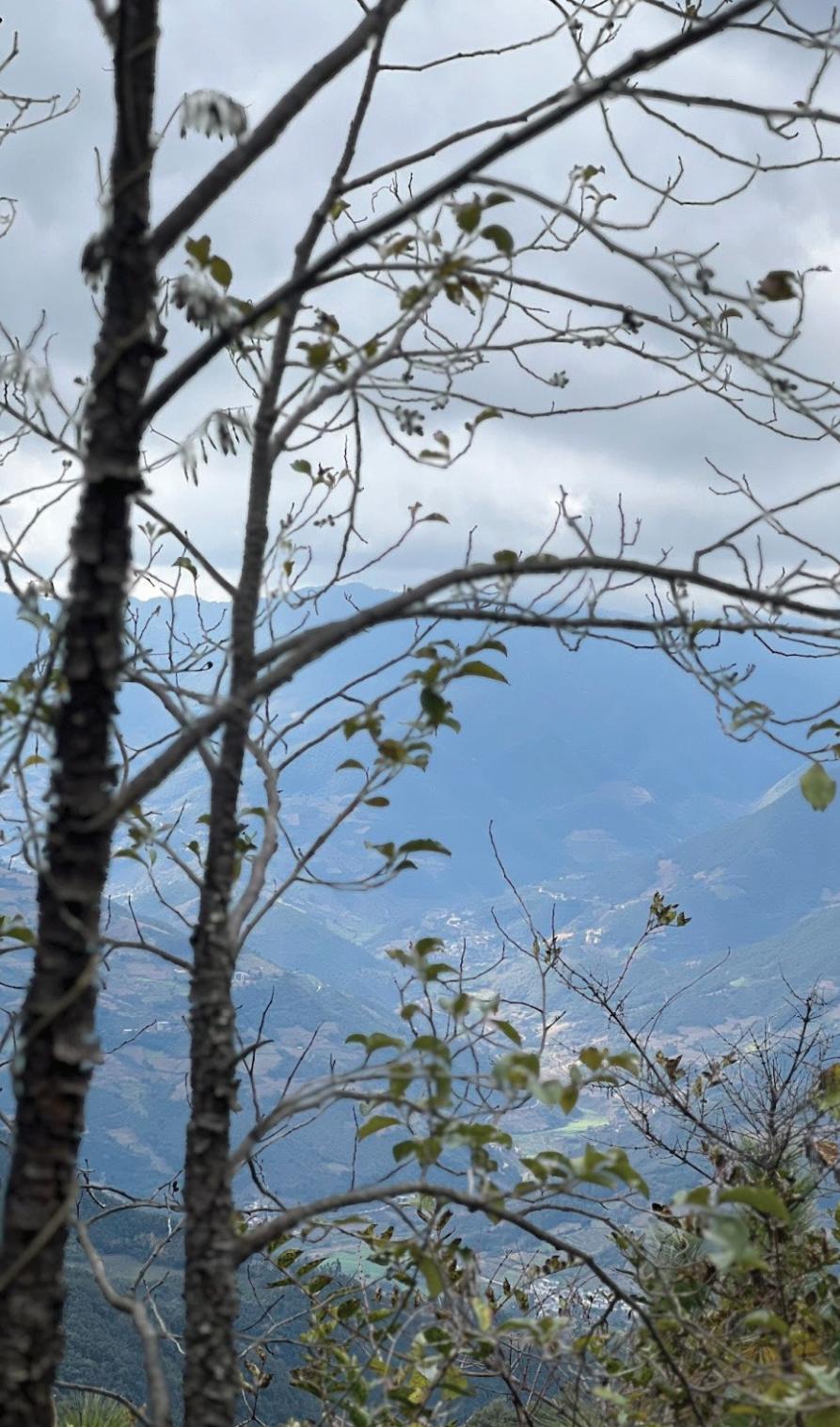
BY:
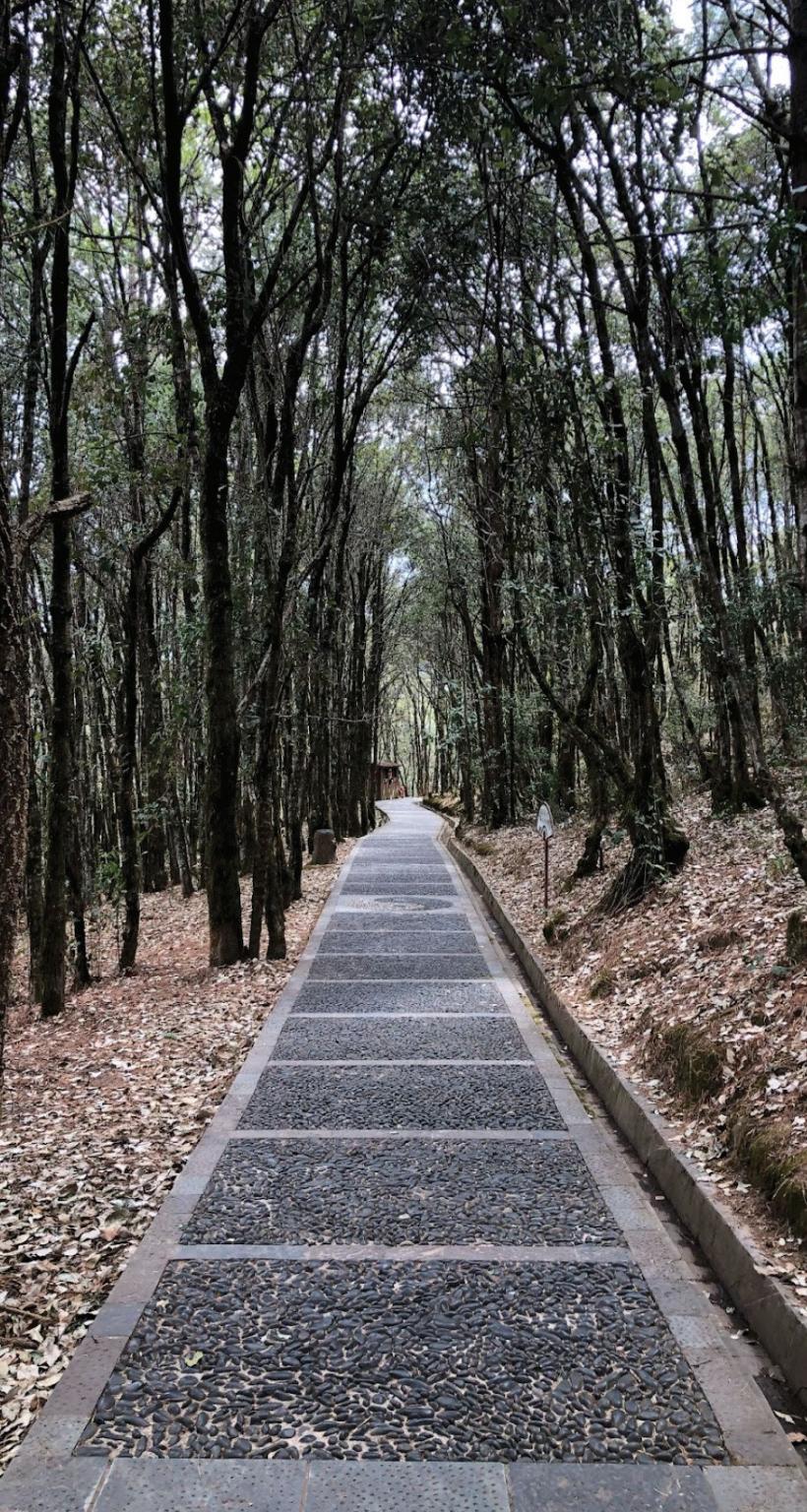
The region of Dali has many wonders to explore, not just the Christmas celebration mentioned in our last issue. It is so diverse and fascinating even the New York Times has recently written an article about the Dalifornia culture here in the mountains of China.
Weishan county with a history of minority’s sovereignty and as a center of old religions is the other destination I visited during my trip to Dali. Yi ethnicity, which have long dwelled in Weishan County, created Nanzhao Kingdom from the 8th to 10th century crossing through Southwest China and north Southeast Asia. The Weishan Ancien Town, which is a popular tourist destination at present, was the first Nanzhao’s capital city, but the authority recently23 changed Nanzhao’s capital to Dali Ancient Town (mentioned in our last issue), which makes these two ancient towns historic and popular. Just behind the Weishan Ancient Town, is Weibao Mountain, which is our destination in this article.
Weibao Mountain, which, translated to English means “the diamond of Weishan county,” is believed to be the sacred religious mountain by locals. It also marks a combination/convergence of local rituals and foreign religions, where dominant Daoist temples from the last three hundred years keep receiving people’s visits and wishes, while Buddhism and local Yi’s rituals also present on Mt. Weibao (this famous Daoist mountain). Beside religion, the evergreen forest on Mt. Weibao and over 1000 meters of elevation attracts hikers to adventure and enjoy time together.
Cars can get directly to and have to stop before the Monastery Gate, which is at two thirds altitude of the mountain. After the Monastery Gate, people formally enter the scenic area of Mt. Weibao, where all temples exist and hiking pathways spread throughout here.
Hiking about 500 meters from the Monetary Gate are the Lingguan Pavilions and the Prince Pavilion. Both Pavilions are small temples, generally consisting of an altar at the center of the courtyards and four resident hells encircling the altar. The Lingguan Pavilion is larger than the Prince Pavilion that is next to it, which is famous for serving Daoist protector gods/Dharmapala (believed to protect people from bad luck and promote promising careers, especially as officials.) and the 400 year-old Red Camellia tree in the pavilion. The Red Camellia tree is also the tallest camellia tree in the world — over 17 meters high, so people can see the camellia tree from all directions – either sitting in the Prince Pavilion or hiking to the higher platform behind the tree.
Referencing the Prince Pavilion, it is a Buddhist temple commemorating Buddha Sakyamuni when he was the prince [before becoming the Buddha], the Prince Pavilion may be the most famous temple on Mt. Weibao since 2019. In 2019, the popular fiction Heaven Official’s Blessing by Mo Xiang Tong Xiu also adapted into an animation film, has drawn a soaring number of tourists to these two pavilions.
The author blogged a surprising coincidence: after she finished the characters’ designs before starting to compose the story, she visited the Prince Pavilion and saw the Red Camellia trees, which connected to her protagonists Huacheng (name meaning: flowers) and Prince Xielian. Also, the author thought the close distance between the Prince Pavilion and the Red Camellia tree coincides with the protagonists’ close relationship with each other [so she felt like a surprise but also destined to bring her here after finishing the characters’ designs]
As the fiction and animation obtained billions of people’s attention in China, many fans came to Mt. Weibao and the two pavilions as a “pilgrimage”.
The Prince Pavilion has experienced a giant change in the past two years, because the ex-priest in the Pavilion passed away in 2021 while the present manager has not much knowledge about Daoism. In the current Prince Pavilion, the posters of Heaven official’s Blessing are messily hung everywhere — on the branches of hydrangea flowers or on the walls of the temple. Though it attracts more fans of the fiction to visit and to donate for the temple, the [unreasonable? Unsustainable? Instrategical] commercialization and “invasion” of pop-culture lead to shriveled hydrangea flowers and to weaken the temple’s beauty.
The Lingguan Pavilion forms a foil to the Prince Pavilion, where its abbot has taken close care to Red Camellia tree and wooden architecture, maintaining an antique beauty of the temples and the calm spirit/quiet vibe of Daoism. The steel scaffolds around the tree can be the evidence showing the abbot’s care to the Lingguan Pavilion, where the abbot periodically climbs up the scaffolds to observe the condition-change of the sick tree as well as to kill pests. The close-care from the abbots of all ages in this pavilion allows the Red Camellia Tree to be lively over the 400 years.
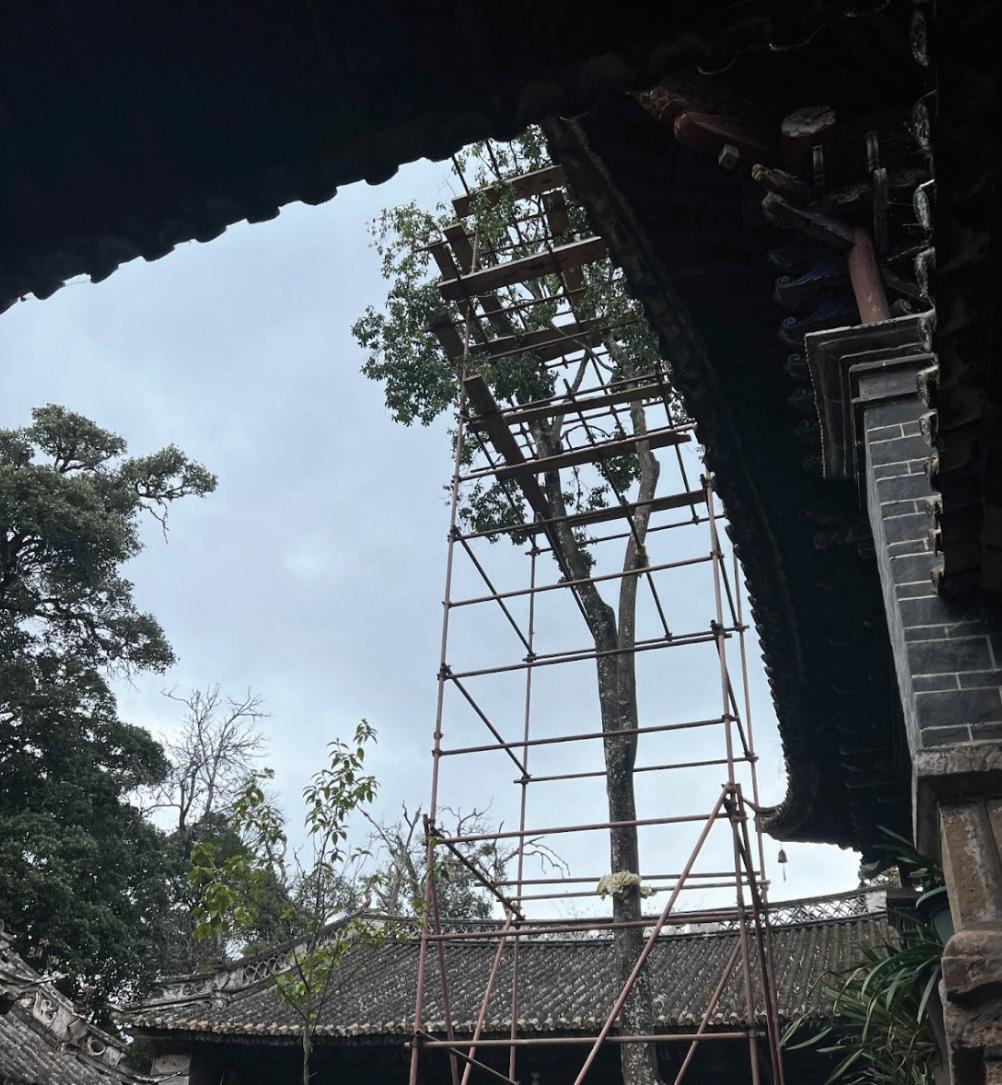
Changchun Cave is another one of the most famous temples on Mt. Weibao, located on the other side of the mountain [To the Prince Pavilion and Lingguan Pavilion]. There are two routes to get to Changchun Cave from the Prince Pavilion — either returning to Monterey Gate or climbing to Peak then heading down to Changchun Cave. Returning to Monterey Gate may be an easier way because its straight-line distance is approximately two kilometers compared to four kilometers going around the mountain peak.
But, it is much more interesting to get to the mountain peak: tourists may pass by several temple complexes, located at different heights. Some of the temples are small with only one pavilion. Some of the temples are huge with elevated platforms, large courtyards and abundant statues, like Doumu Pavilion at the mountain peak where one female abbot with a cute teddy bear dog lives. Seeing abbots and pets living in temples together breaks the distant or serious tone that religions sometimes make people feel.
Hiking at a height also allows me to view winding mountains at a distance and villages extending in valleys without an obstruction. Though this route may be time-consuming (at least 2-3 hours) and energy consuming (fast heart beats and quick breathing rate), it is totally worthsome if [you] enjoy both humanity and exercise.
From the exterior, the main temple has two floors, though the second floor has only carved windows. Inside, it is one hall, and the over-human sized sculpture of Jade Emperor, the leader of Daoist heaven, stands on the elevated altar. The beams of sunlight from the second floor carved window form an intense contrast to darkness all around. This also makes the incense smoke visible, which symbolically blurs the lines between the virtual and real. Most interestingly, at the center of the ceiling, one sculpture etched into the ceiling highlights a dragon, coiling upward to the sky, which mimics the Daoist image of heaven. This emphasizes the power of the dragon, a representative of the gods and the emperor, coiling upward to symbolize the power each person has to move forward and upward with a positive mindset. This is similar to Baroque-style churches, like Il Gesu Church, which utilizes romanticized and vivid images of heaven to convince audiences the existence of gods or heaven. Here, however, the symbolism emphasizes harmony with nature,the world and oneself. The weather on Mt. Weibao is warm, and flowers — plum blossom, waterlily, chrysanthemum, and more — bloom profusely, which matches Changchun Cave’s name meaning—forever spring. Beautiful nature, fresh air, and hiking activity have made Mt. Weibao, not only a tourists’ destination but also a perfect place where families with children enjoy hiking and freetime.
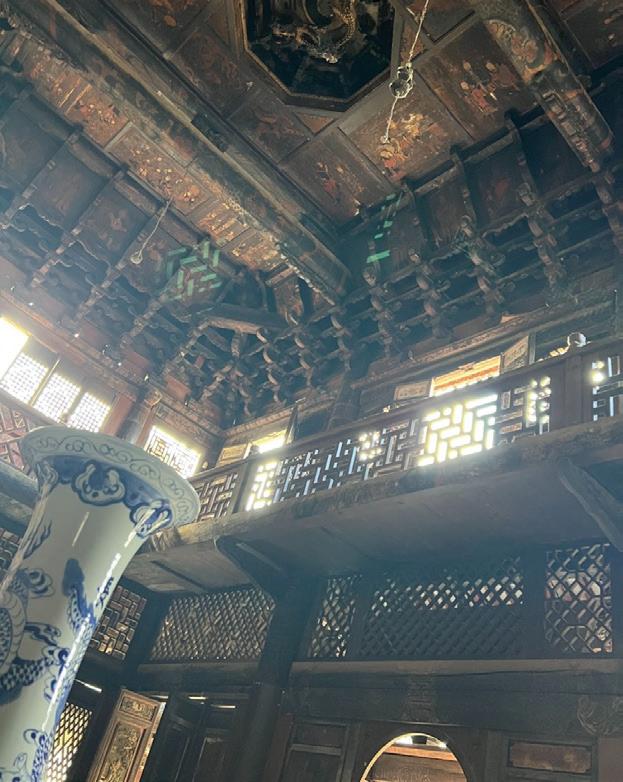
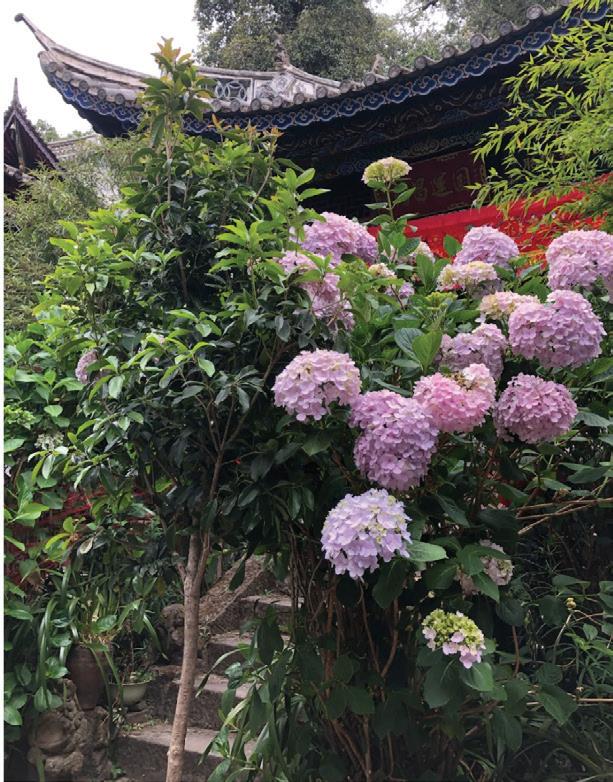
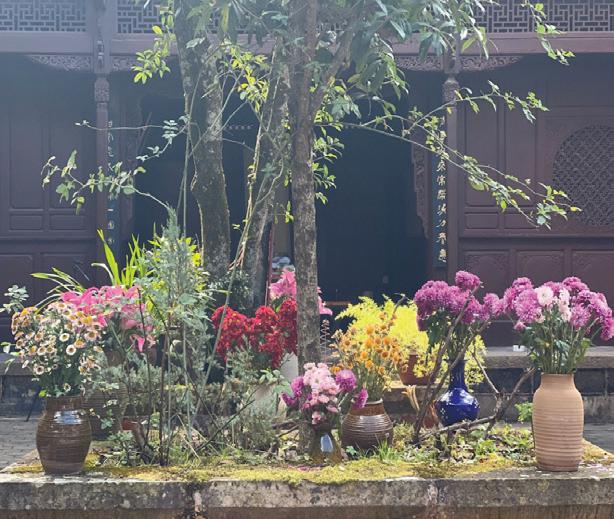
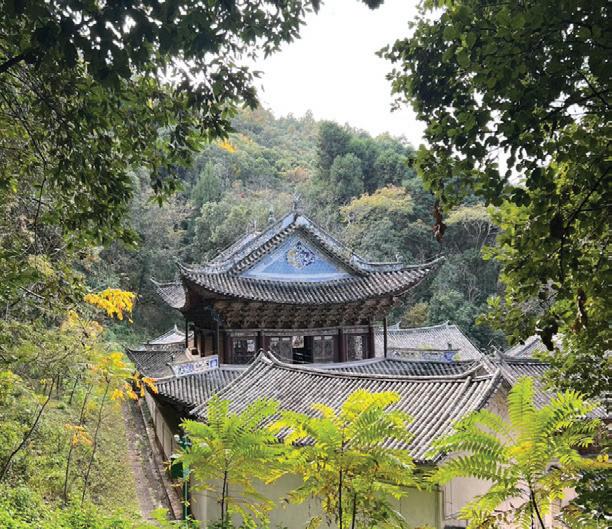
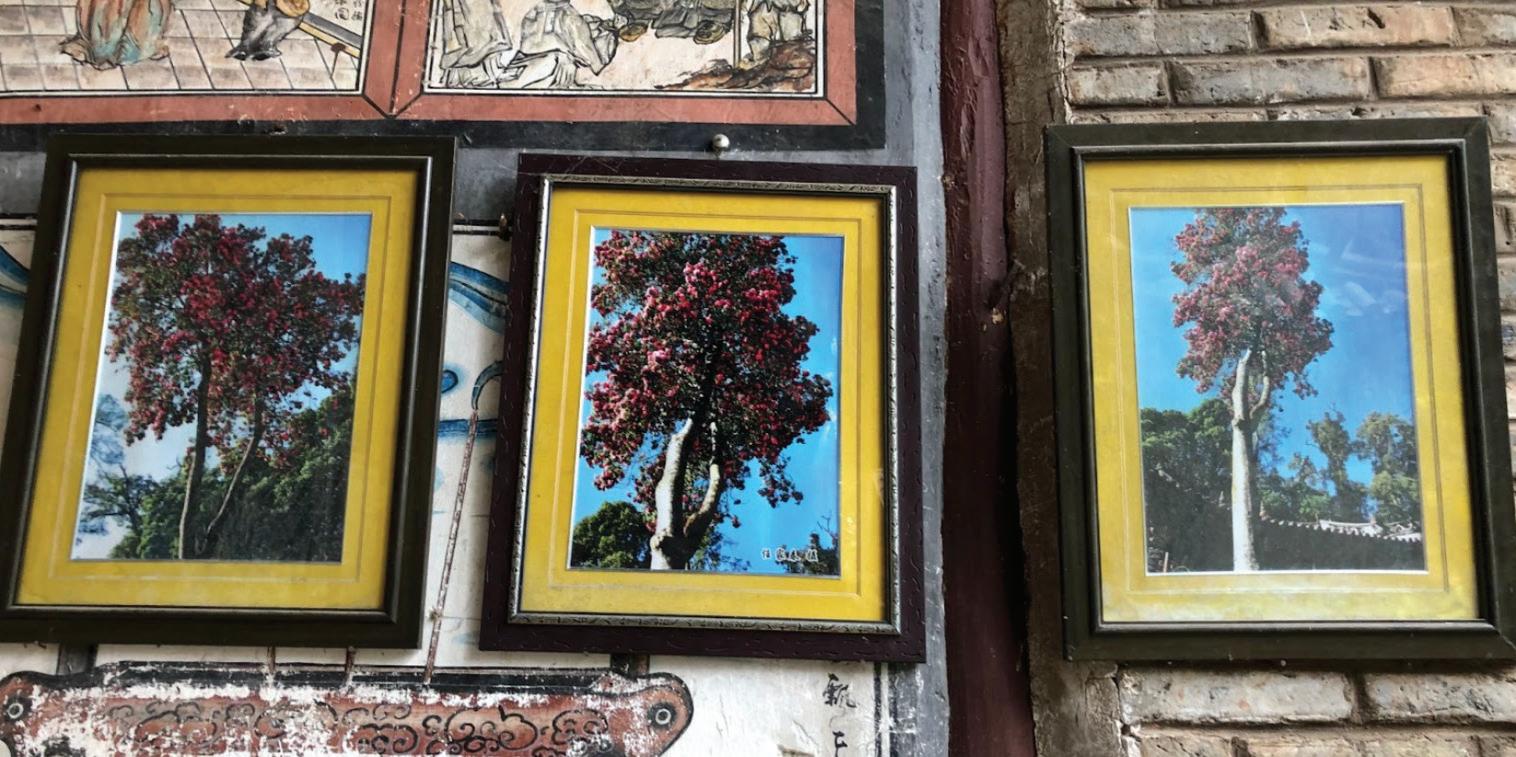

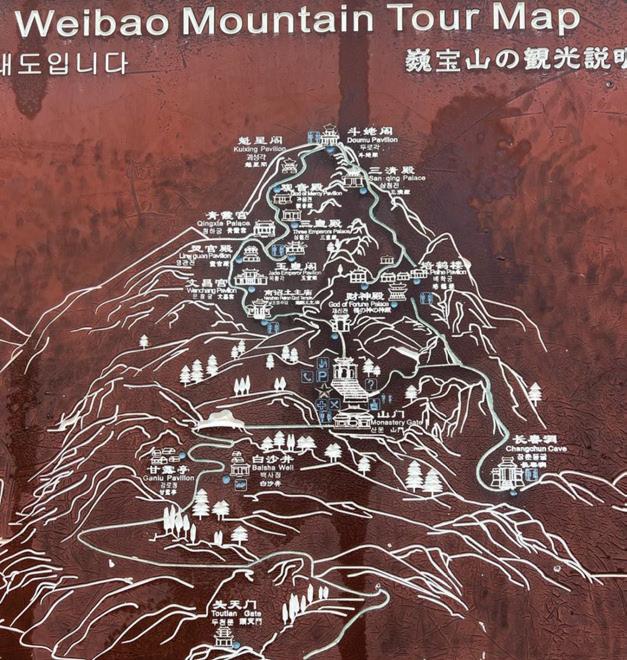
PHOTO CONTEST WINNERS
Statments gathered by Sarah Wang
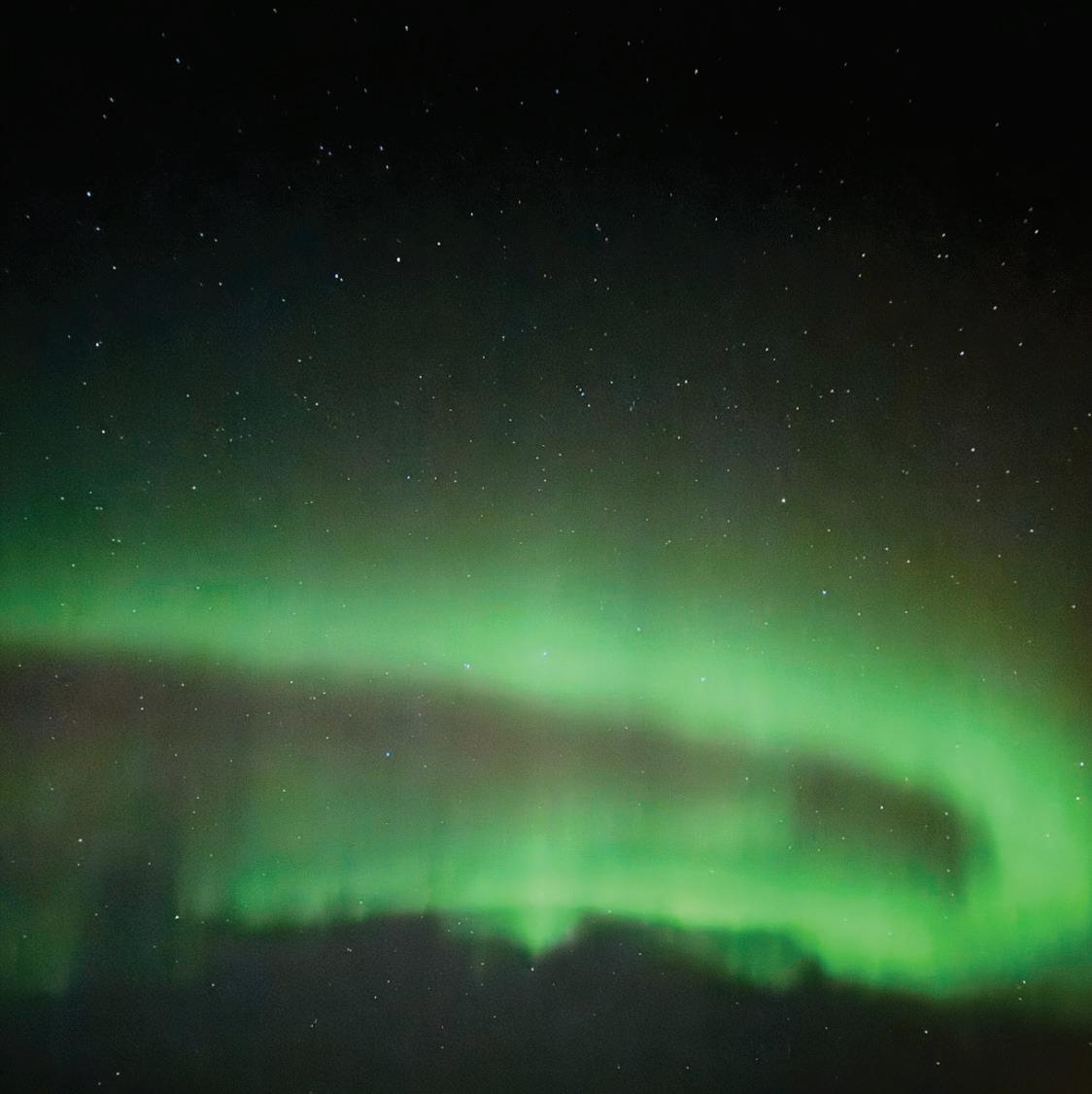
Emy Castle
Red Tie USG
Category: Thanksgiving Break
“Ms. Corrigan woke us up at midnight and told us that the Northern Lights were out so everybody ran and put on clothes and shoes. We got a bunch of pictures of the Northern Lights and it was really awesome even though everyone was super tired.”
Peyton Matthews
Red Tie USG
Category: Winter Break
“This image was taken in Paris, France in January of 2024 while I was on my school exchange program. It was so beautiful being able to witness it [The Eiffel Tower] lit up; it’s something everyone should try and experience once in their life.”
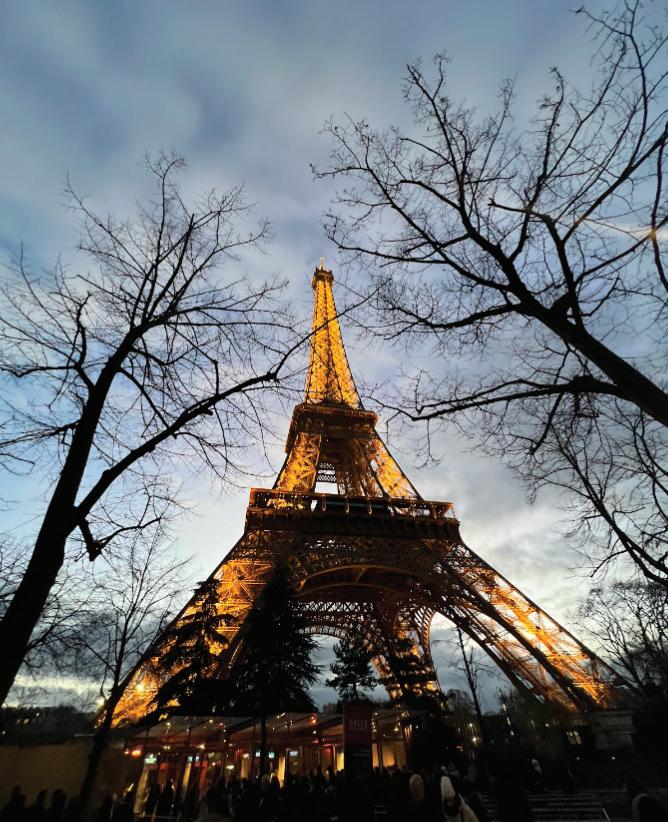
Kevin Nguyen
Green Tie USB
Category: Winter break
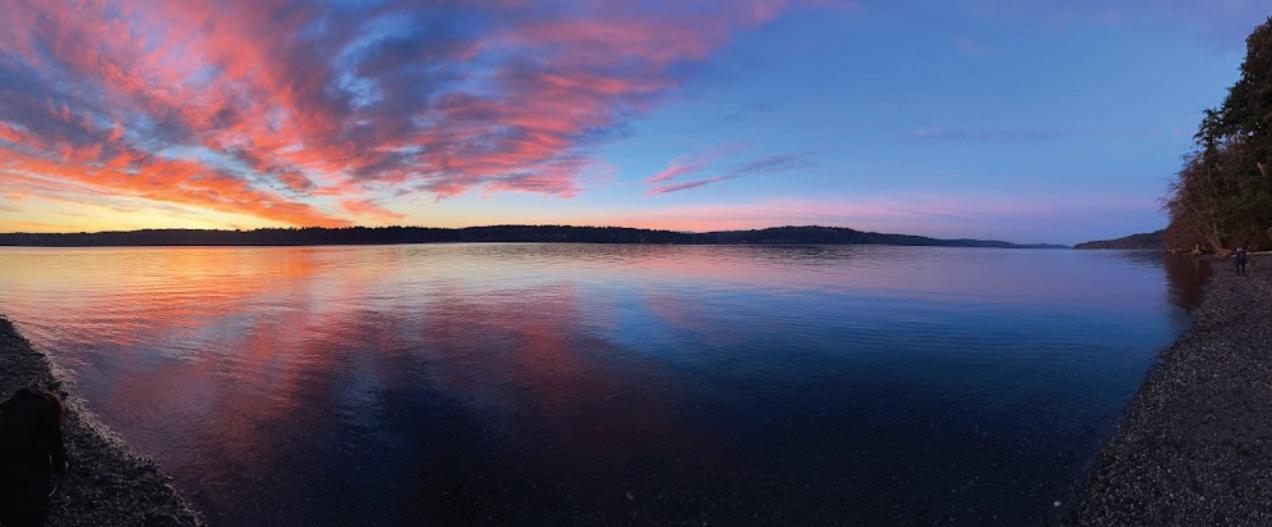
“It was a dinner party with some of my bestest friends in Vashon. We had a nice little stroll down to the beach and just watched the sunset. I’m not really a photographer, but I wanted to remember the moment.”
PLAY REVIEW
Some were trapped for months in bleak rooms with little outlets or resources connecting them to the outside world. The barren walls enclosing their struggles surprisingly were one of the sole things giving any sense of community. The walls were riddled with poems from past immigrants. Paint job after paint job could not take away the etchings from past inhabitants of the immigration centers on Angel Island. This spring, Berkeley Repertory showcased an ingenious production of “The Far Country”, a play written by Loyd Suh that focuses on capturing the experience of being an Immigrant on Angel Island. In 1882, the Chinese Exclusion Act was passed requiring certain certifications and qualifications from the Chinese government in order to migrate.However, it became harder and harder for Chinese laborers to be qualified and granted immigration rights as“the 1882 act defined laborers as “skilled and unskilled...and Chinese employed in mining.” There was also a rule requiring Chinese-American people to bring their relatives to the United States from China if they were related. This started the common occurrence of “paper sons and daughters” where which many immigrants were able to travel to the United States under faked documentation of descending from United States citizens. Upon reaching United States grounds, many Chinese immigrants were stuck in prison-like conditions on Angel Island, just off the coast of San Francisco. Immigrants were not given any idea of how long they would be detained, so the stay felt indefinite to many of them. The play follows a Chinese Immigrant
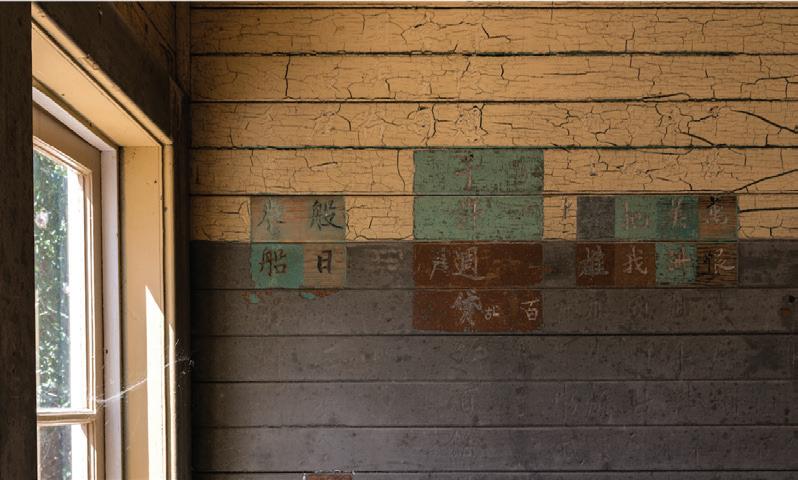
The Far Country Lucy Hall
named Fee and his visit to China. Fee attempts to bring a boy named Moon Gyet to San Francisco as his “paper son” in order to get money from the boy’s mother. The show brought a unique lens to the immigration of Angel Island, specifically with the scenes of translation. The show opens with an interrogation scene between the character Fee (played by Feodor Chin), the inspectors at Angel Island who decides the fate of the man, and the translator for the two. Instead of going from Chinese to English
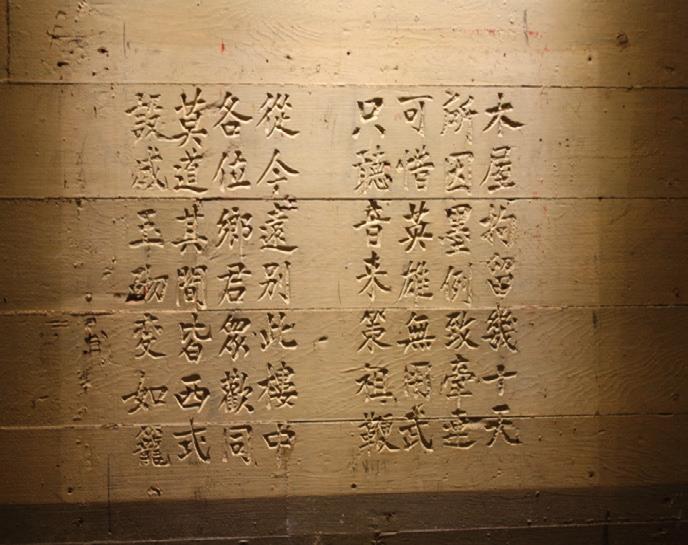
when Fee is speaking, Fee and the translator both speak in clear english, with the translator’s speech overlapping with Fee’s words, saying them just second behind him. The audience is almost overrun with frustration that the investigator does not understand words that are perfectly coherent to the rest of the audience. In a way, this reflects how it feels to be a Chinese speaker because everything that an immigrant would be saying would be perfectly coherent, however, the amount of respect that they get for being coherent in their own language is not comparable to the amount
that they would get in English. These translation scenes allow the audience to feel a sense of frustration at the lack of understanding the guards have of his perfect language which prompts the audience to reflect on the deep frustration that must come with being intelligent, well spoken, and fluent in a language not appreciated by your new home. The process these immigrants go through is incredibly grueling. The most outstanding moment was at the very end in which Yuen (Sharon Shao)performed a monologue to a dying Gee (Feodor Chin). The audience felt a bitter. sweet exchange between the two Gee, who originally brought the young boy Moon Gyet to the United States,later brought Yuen over with him. In his age, Gee has lost much of his memory, so in this scene, Yuen movingly reminds him that even if he mentally cannot recall all the turmoil, joy, loss, and gain he had to go through to get to where he is, Gee’s Body remembers. She reminds him that whilst his memories escape him, his physical being will not forget, and neither will history.
Sources
“Barrack Poetry.” Angel Island Project: Journeys to the Past, bhsangelisland. weebly.com/barrack-poetry.html. Accessed 21 May 2024.
“Poems and Inscriptions: Angel Island Immigration Station - San Francisco.” AIISF, www.aiisf.org/ poems-and-inscriptions. Accessed 21 May 2024.
STADIUM BASEBALL AND SOFTBALL
Jack Cushman
What was your favorite part of your season? What was your record? What are your future plans for baseball? Why do you play baseball/what do you like about it over other sports? What position do you play and what do you like about it?
Peyton Mathews
I play for the Stadium Softball team. My favorite part of our season was just getting to play with some really cool people! I have built a lot of friendships outside of Annie Wright through this team. There is such a wide range of people who all get along so great, on and off the field. We are a very skilled team, in hitting and defense, all our players have lots of experience and really have a passion for the sport.
Our record this year during the regular season was 13-2, where our only losses were to Bonney Lake, a team currently ranked second in district. We unfortunately didn’t finish great in the postseason and were knocked out of a spot for State Championships by Timberline, the 2nd ranked team in the state. We put up a good fight but that truly is a group of talented girls. Softball is genuinely such a great sport because of the time of year. Getting to be outside in March through May is wonderful and nothing beats a night game in the summer.

It’s also super fun because anyone can play, whether with little kids or with your parents, it is always nice to get outside and toss around a ball. I currently play right field and I love getting to track down fly balls and make that exhilarating catch. It sounds mean but it feels so good to rob someone of a great hit! Being far out in the grass is incredibly peaceful, a great way to see everything going on.

I currently just plan to continue playing through High School. I have played this sport since I was about four years old, hitting and throwing with my dad, but officially started on a team in third grade. Softball has always been something I look forward to in the springtime, it’s a great way to be outside in the perfect weather!
Eli Weir
My favorite part of the season was playing with new kids, most of whom I had never met before. Our record was 11-4. I love baseball because of how unique it is. For example, we have innings instead of an amount of time. My primary position is Catcher and I like it because I get to be involved in every play and get to make the exciting plays at the plate. I hope to play baseball at some college level and possibly even beyond that.
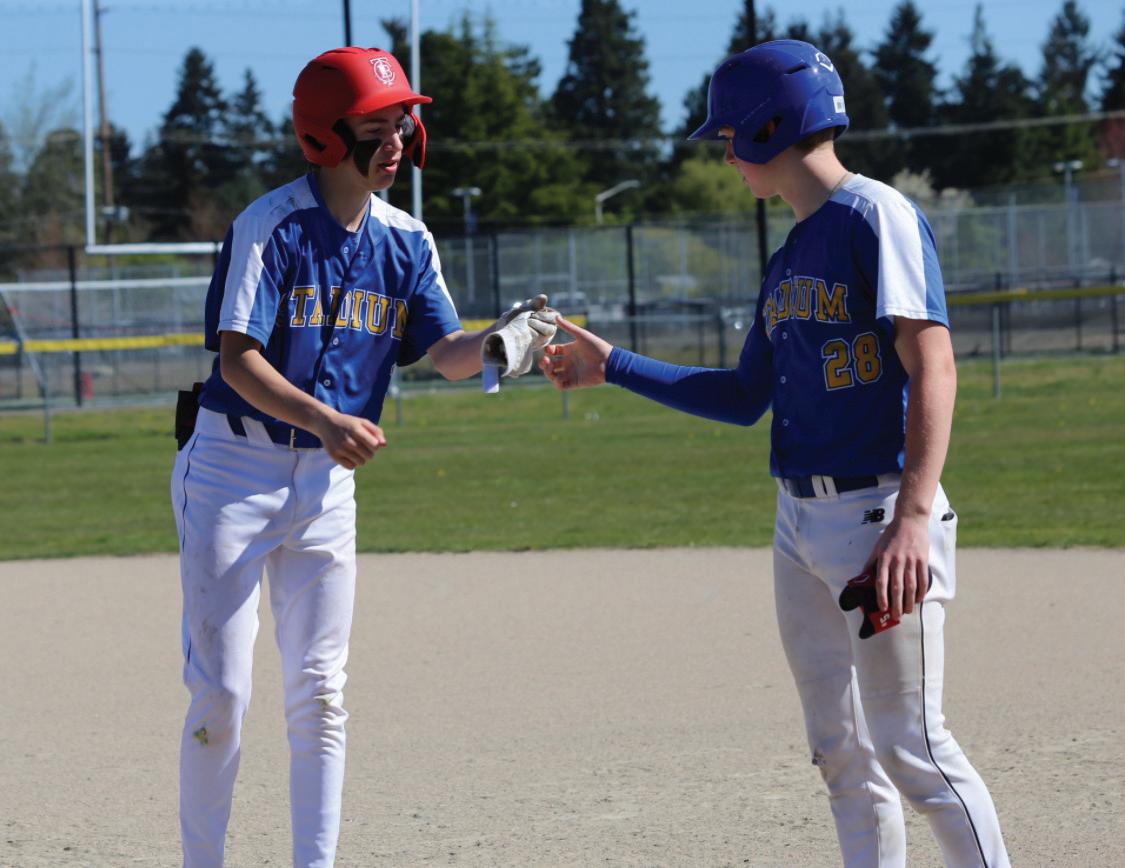
Aiden Bailey
My favorite part of the season was definitely the games and the team and the competitiveness of my team even if other teams were not great. Our record for this season was 12-3.
I play baseball over other sports because it’s what I have played my entire life. I just enjoy the mental part of the game and the strategy that is involved. I play Center Field, and I like it because I get to make the hardest plays and track down fly balls or line drives. I plan to play baseball in college but don’t plan to keep playing after that.
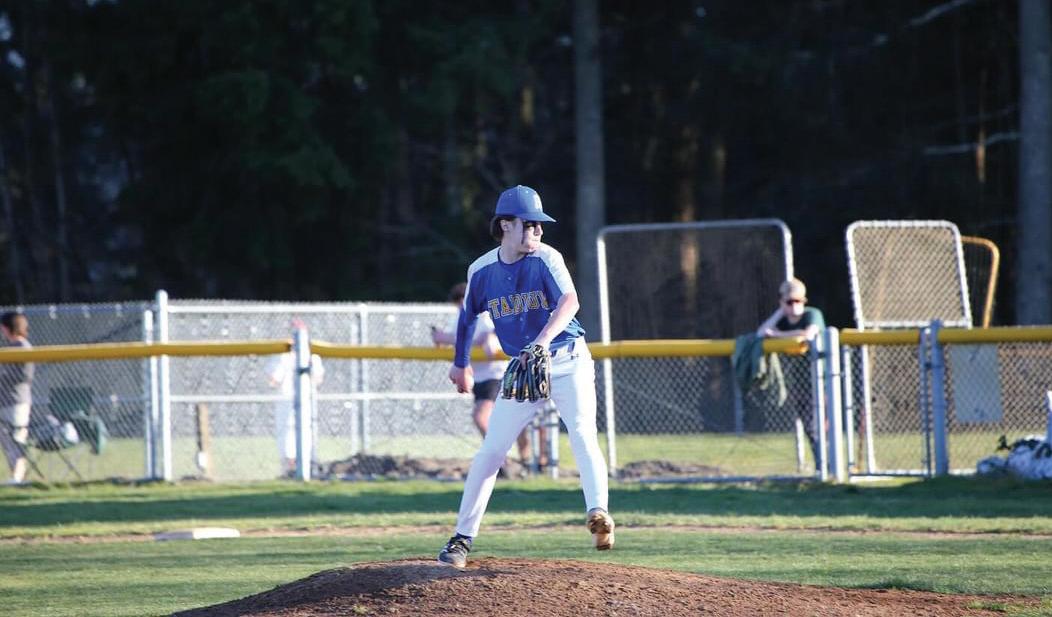
HOW FAR ARE PEOPLE COMING FOR SCHOOL?
Ellis Giller

These are maps that shows where our student body is traveling from to get to school. Whether it’s international or domestic, we wanted to recognize the effort it takes some people to simply get to school. We also wanted to display how international our school truly is.
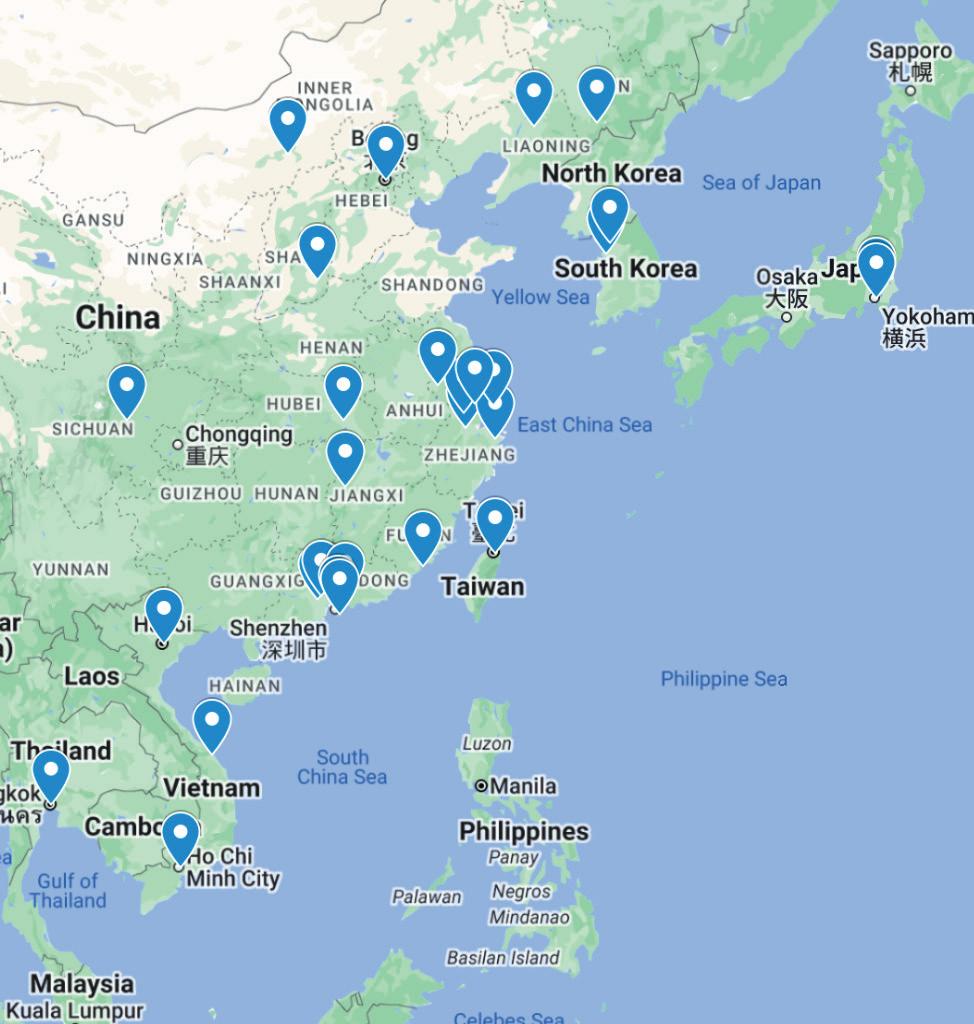
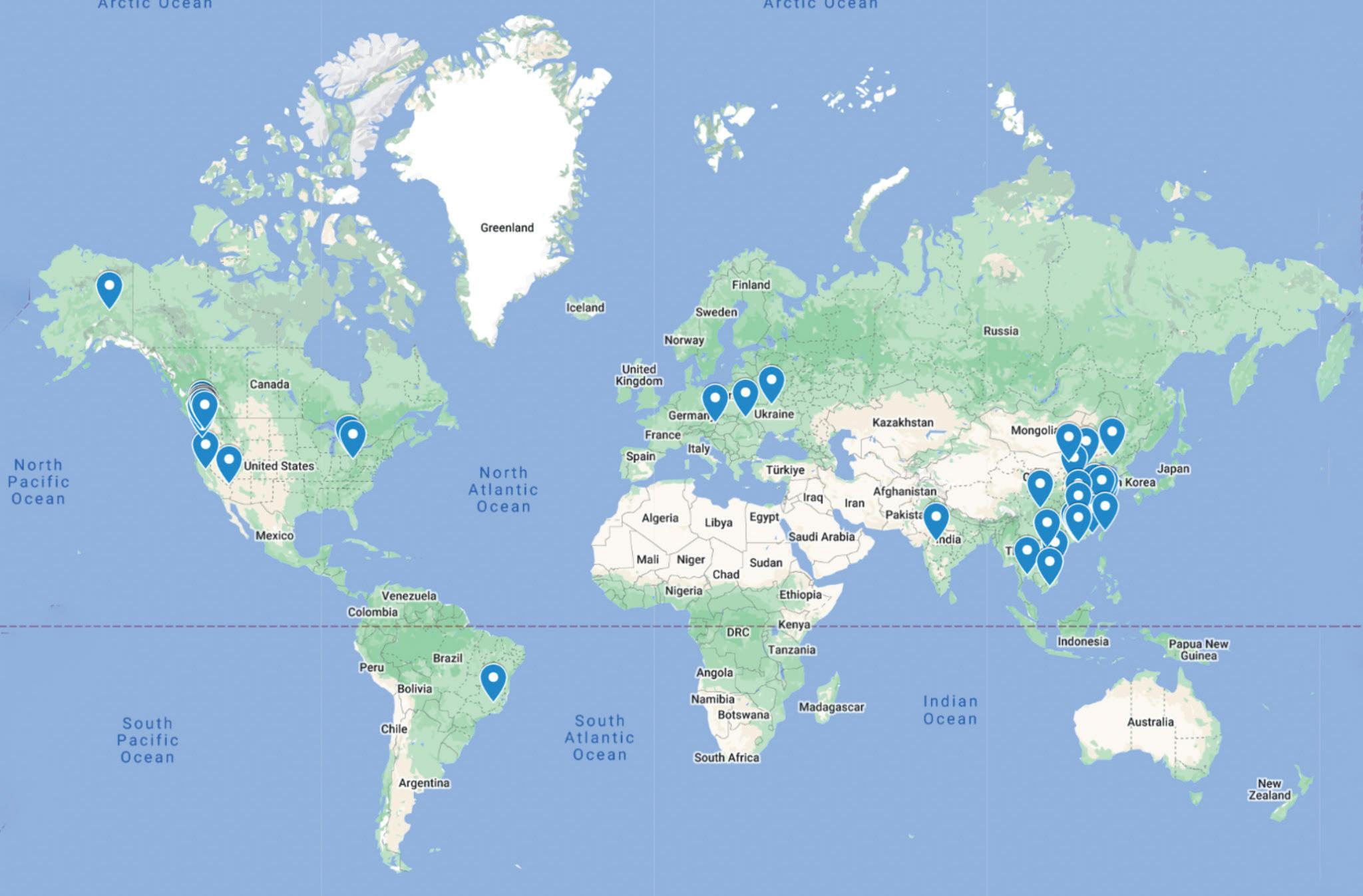
https://www.google.com/maps/d/edit?mid=11a7g6v7WGa-yaZJ_V_acZY8XW3OKgOg&ll=1.8567492029500343%2C0&z=2
Austria:
Klosterneuburg
Brazil:
Belo Horizonte
Canada:
White Rock
China: Baishan
Beijing Changzhi
Chengdu
Dongguan
Foshan
Guangzhou
Hangzhou
Hangzhou
Zhejiang
Hohhot
Huizhou
Huzhou
Nanjing
Ningbo
Shanghai
Shenyang
Shenzhen
Suzhou
Wuhan
Xiamen
Yichun City
Hong Kong
India: Indore
Japan: Meguro
Yokohama
Korea, Republic of Hwaseong-si
Seoul
Taiwan, Republic of
China
Taipei
Thailand
Bangkok Ukraine
Chernihiv
Kalush
Da Nang
Hanoi
Ho Chi Minh
City
United States Vietnam
Bainbridge
Island
Bellevue
Buckley
Burien
Enumclaw
Grosse Pointe
Park
Issaquah
Kirkland
Lacey
Lake Stevens
Las Vegas
Marysville
Medina
Olympia Port Townsend
Portland
Redmond
Renton
Sammamish
Seattle
Snohomish
Tacoma
University Place
Yarrow Point
Auburn
Bellevue
Black Diamond
Bonney Lake
Buckley
Burien
Covington
Des moines
DuPont
Edgewood
Enumclaw
Fairbanks
Federal Way
Fife
Fircrest
Fox Island
Gig Harbor
Graham
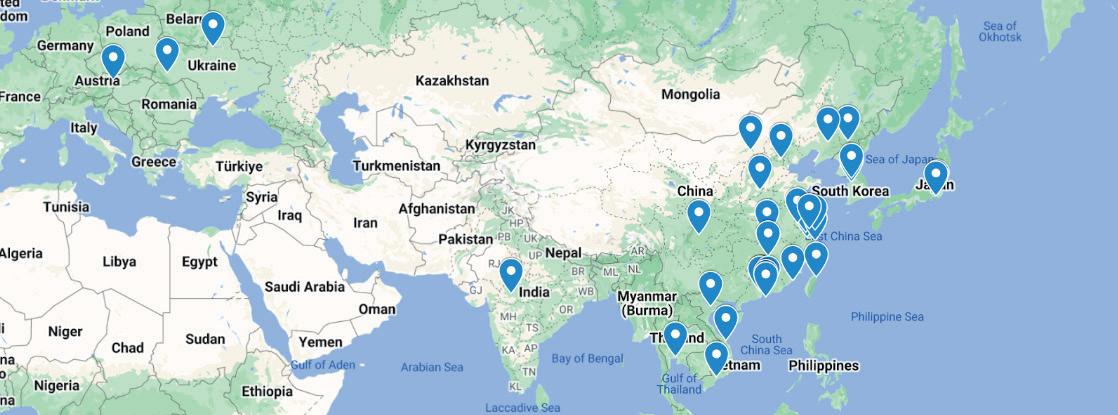
Grapeview
Issaquah
JBLM
Kent
Lacey
Lake Tapps
Lakewood
Longbranch
Maple Valley
Milton
Olympia
Orting
Port Orchard
Poulsbo
Puyallup
Rio Verde
Roy
Ruston
Seatac
Spanaway
Steilacoom
Sumner
Tacoma
Tumwater
University Place
Vashon
Wilkeson
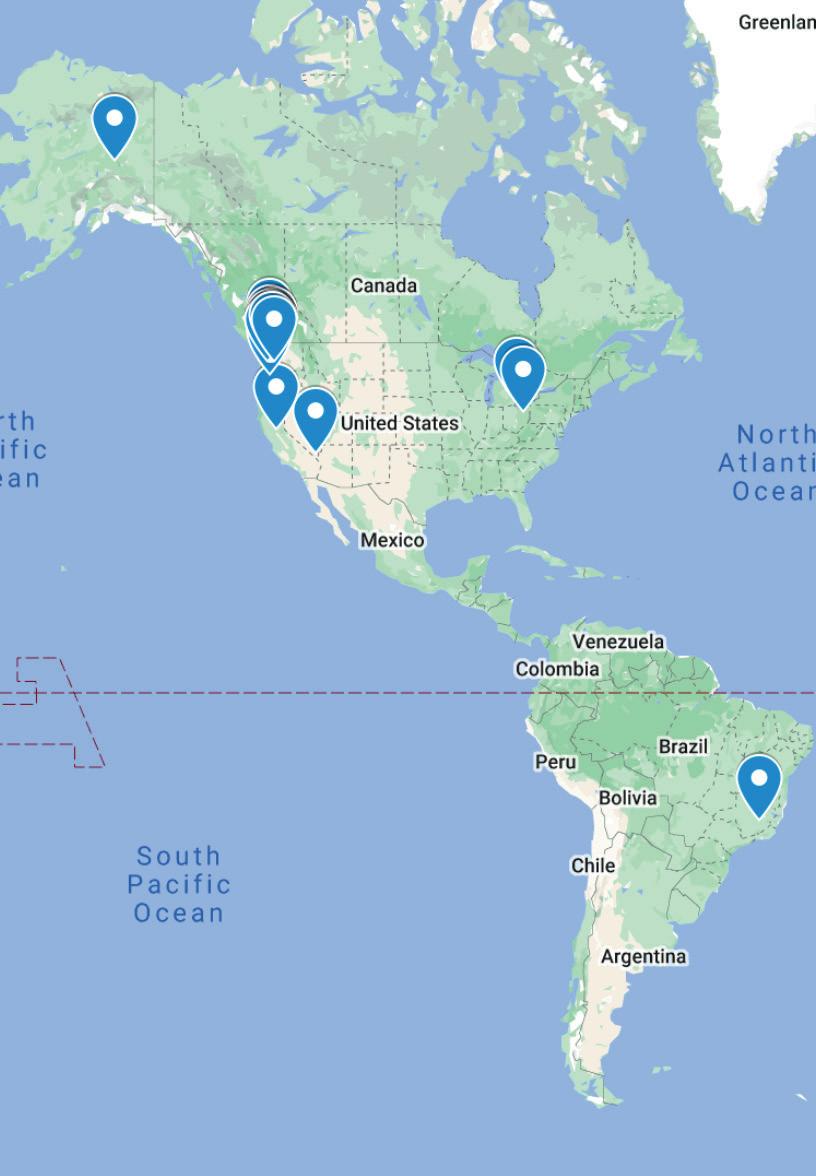
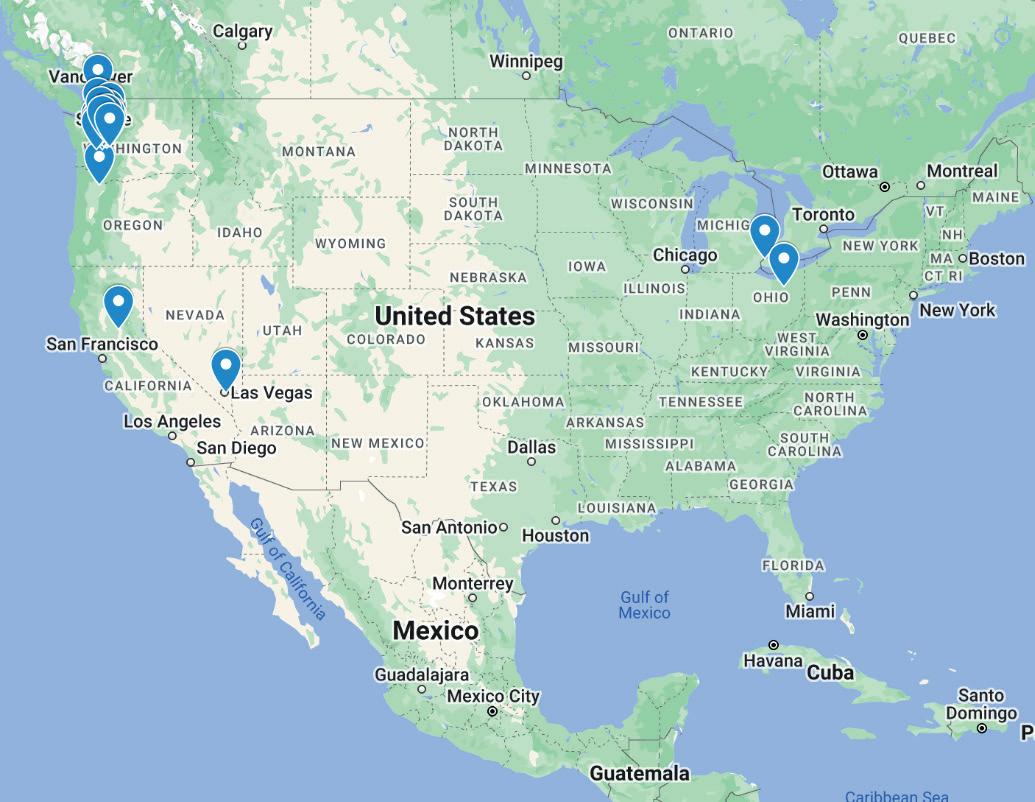
VARSITY ART & IB ART EXHIBITION
Minh Nguyen and TT Nguyen
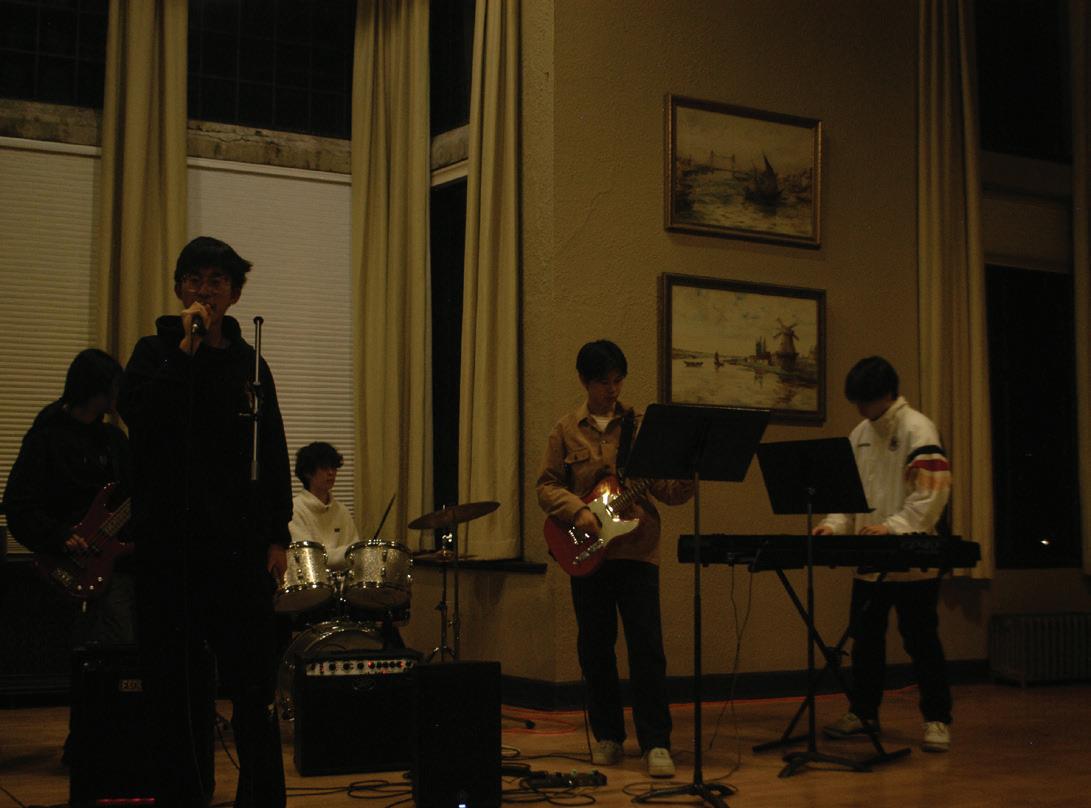
The artist laureate program is a musical and artist program for interested students at Annie Wright. For musicians, they work together or independently to practice different songs and combinations of instruments in order to independently create new music and/or practice working in order to explore their talent and interest with music and performance. It provides many performance opportunities on and off campus such as open mic or on campus showcases.
You can also practice recording songs or if you prefer stick with live performance. The Exhibit is the final showcase, where students present their recorded or live performance work to the Annie Wright community. The program provides a lot of freedom and opportunities for students to explore their interests in music or the arts together or with a tutor.
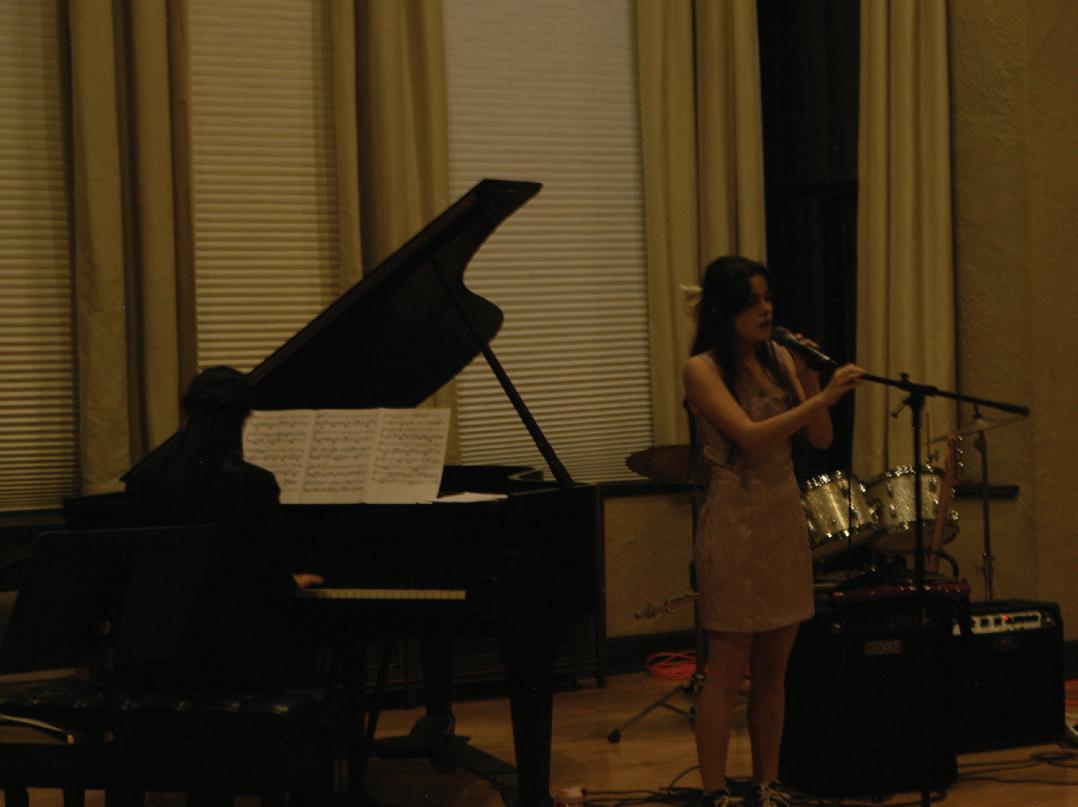
The Artist Laureate and IB Art Exhibition takes place around March each year; it serves as a place where students can freely talk about and showcase their talents in both visual and performing arts across all year groups at Annie Wright Schools. Throughout the event you can enjoy various art and music works from different cultures performed by our students. You can feast your eyes on the amazing creative works completed in various mediums and techniques created by our Art Laurate and IB Art students. The Exhibit is the final showcase, where students present their recorded or live performance work to the Annie Wright community.
From fashion design to photography to paintings and multimedia installations, viewers are awed by the artistic talents of our students and also explore their thought processes through detailed artist statements placed next to the work or explained on stage for live performances. It is an inspirational experience celebrating our very talented Annie Wright musicians and artists.
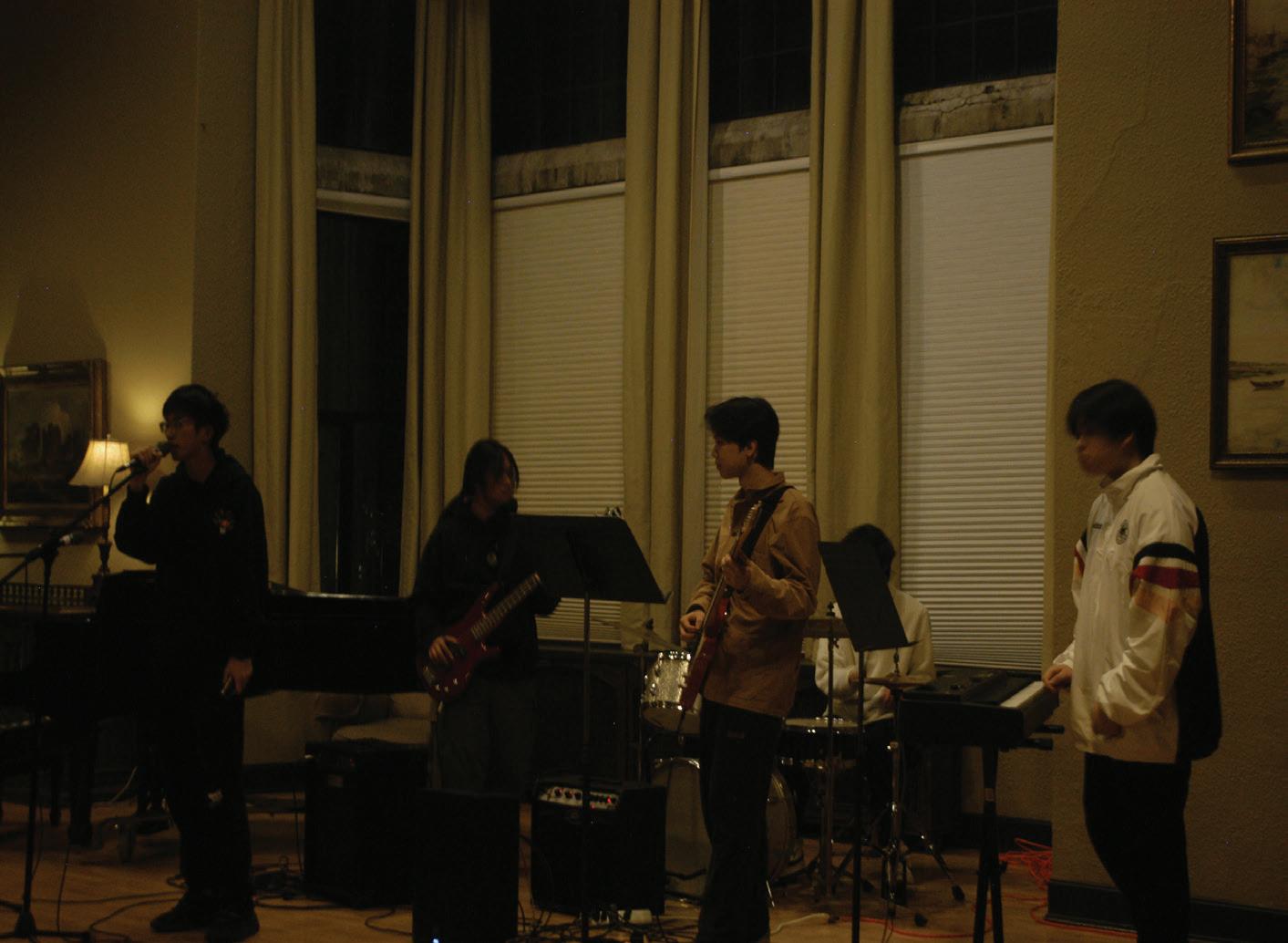
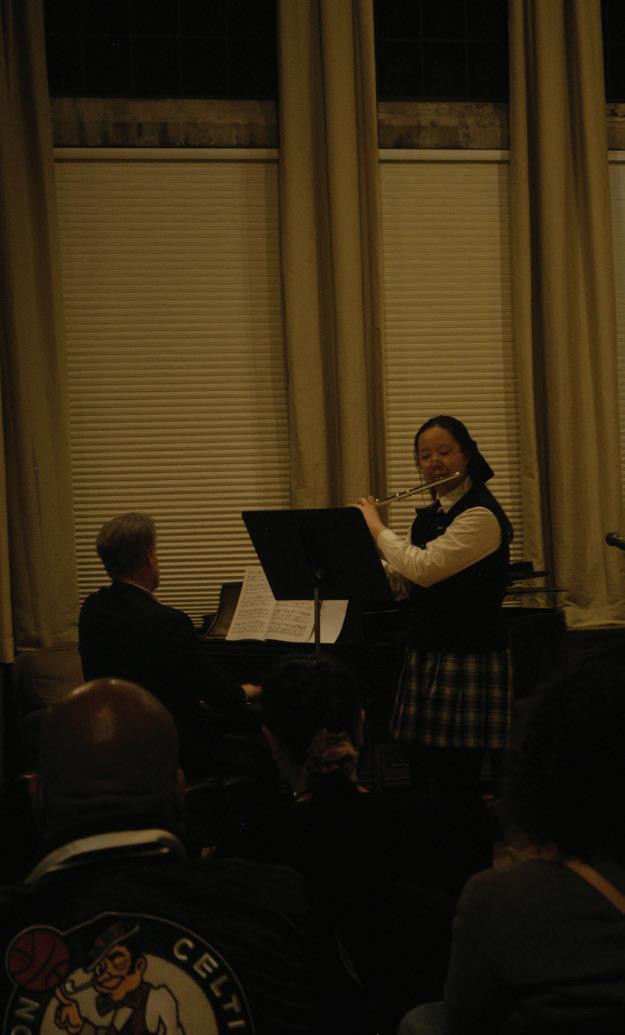
CARNIVAL OF GAMES
Minh Nguyen and TT Nguyen
Carnival of Games takes place around March 17th every year. It is a gaming event where both USB and USG can gather, play board games, strengthen bonds and create new relationships and overall just have fun. Competition ties it all together as the Carnival Games includes a lottery like system for people who participate to have a chance to earn prizes, like cool looking t-shirts designed by our students. Games, competition and prizes combine to make this an unforgettable night.
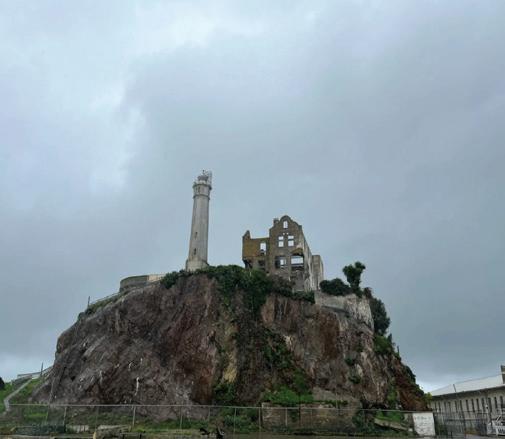
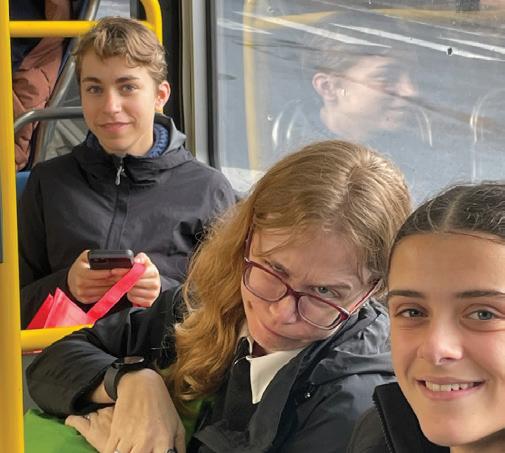
Throughout the event, students rove the Great hall, trying to play as many board games as possible in order to win as many lottery tickets as possible. Students can win anything from civvies passes to T-Shirts to Polaroid Cameras.
The large collection of board games ranging from chess to some more unique student designed board games, allows participants myriad ways to win!
(S)ELECTIVE TRIPS
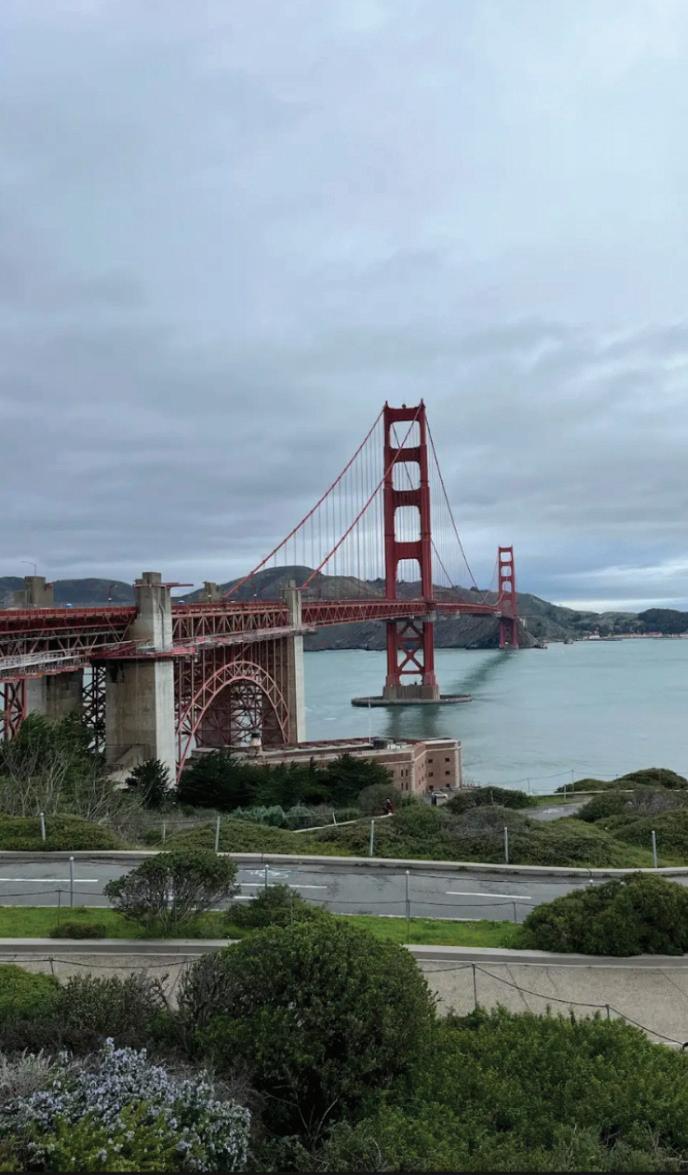
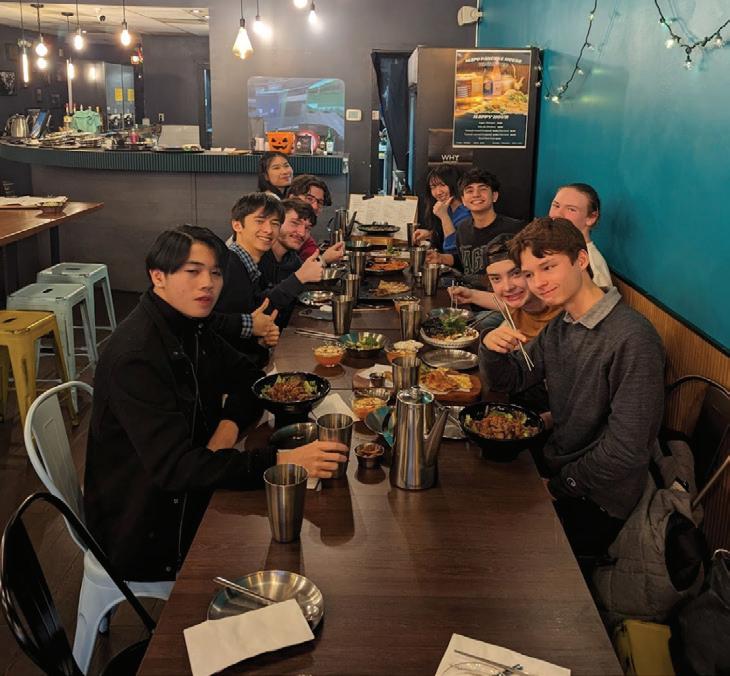
AUTOMOTIVE ART: BERLIN, GERMANY
“Visiting different museums around the city and going axe throwing!” was Emma Adams, the USG Yellow Tie’s, favorite part.
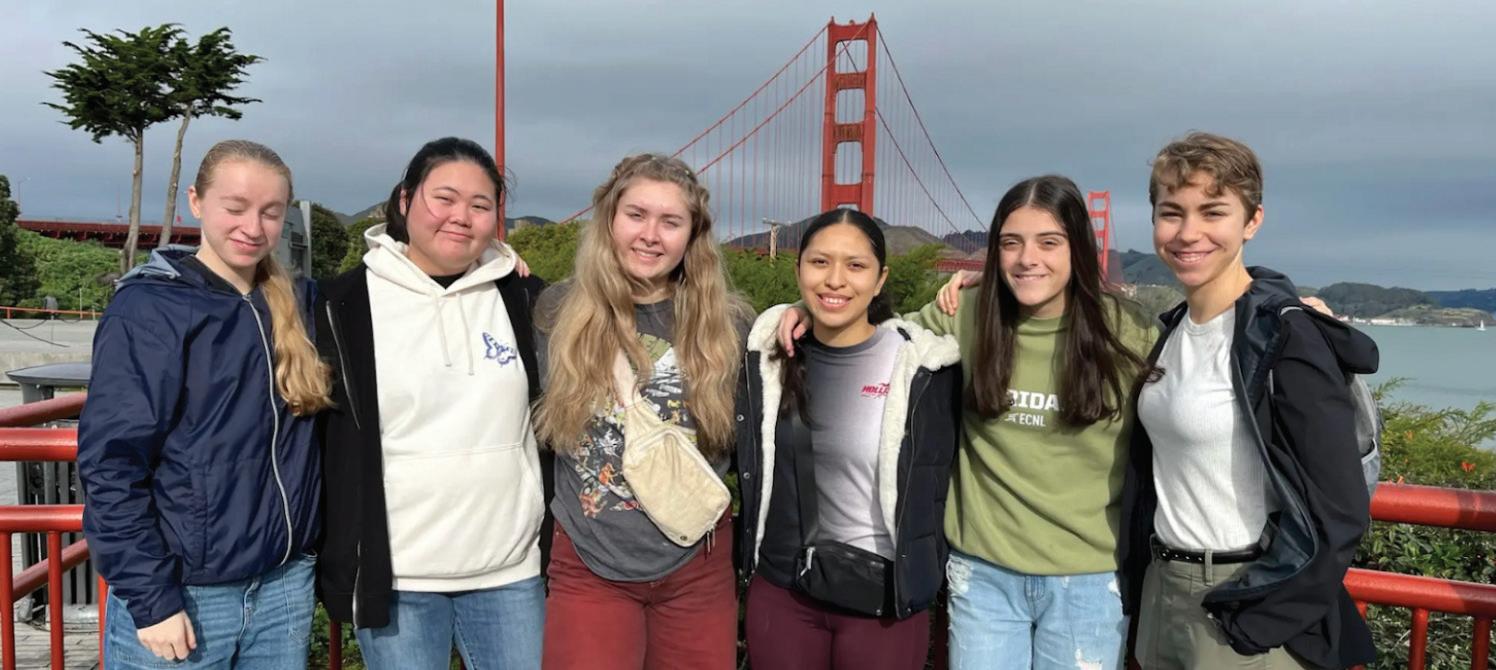
SL&G: SAN FRANSICO, CALIFORNIA
“I loved our cooking challenges (3 people work as a team to make dinner for everyone), and also really enjoyed our team-bonding moments in an escape room!! (We made it out).” Ellen Heacock - USG Yellow Tie
BUSINESS: VANCOUVER, CANADA
“On one day, we went skiing for more than half the day and it was really fun. Afterwards we went to a hockey game and it was the first hockey game I’ve ever been to so it was really interesting.” Di MaUSG Yellow Tie

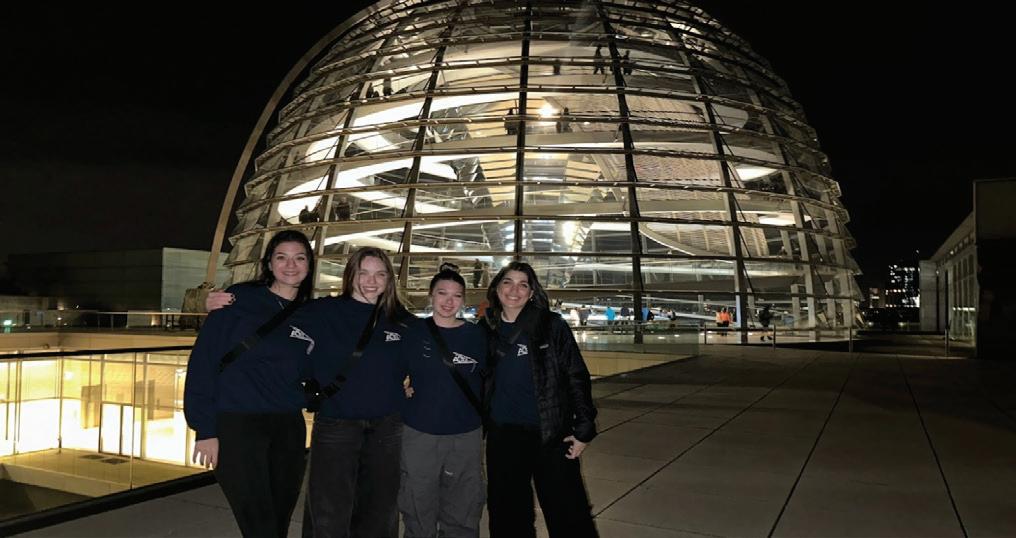
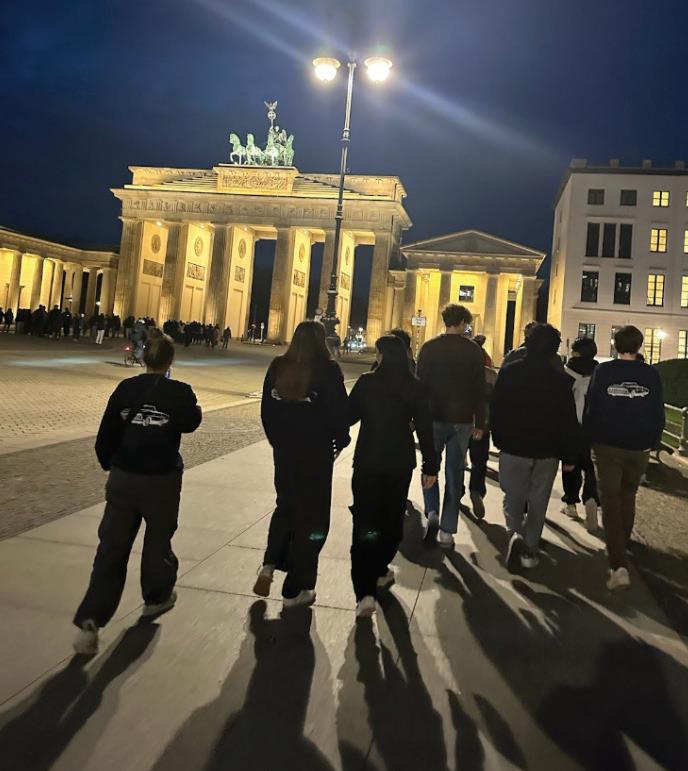
MODEL UNITED NATIONS:
RAWANDA, AFRICA
“I think that one of my favorite moments was going to see the monkeys, they were super cute and very used to humans so they came very close to us. I also think that the beading class was one of the best moments because it was very relaxing and I learned how to make earings.” Haylee Park - USG Yellow Tie
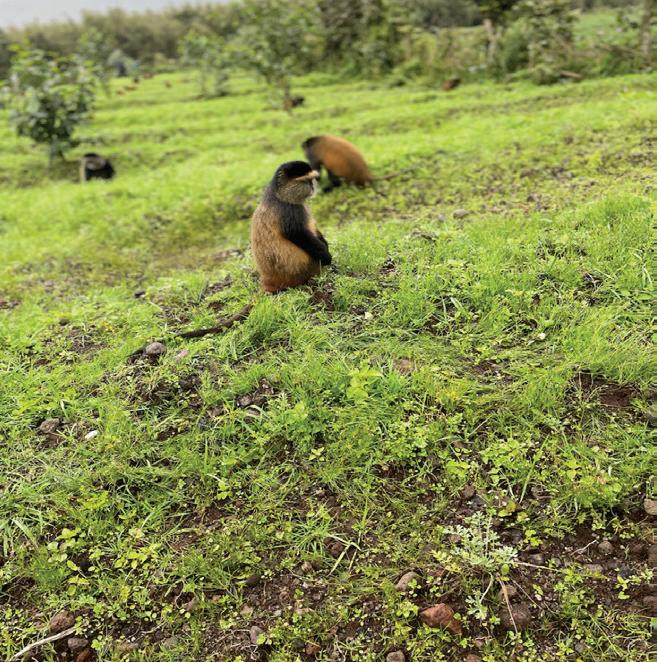
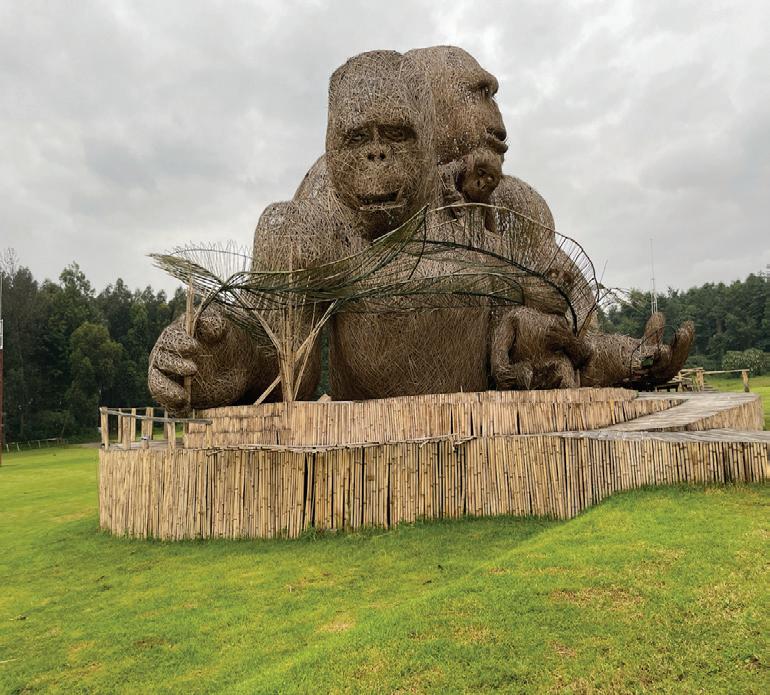
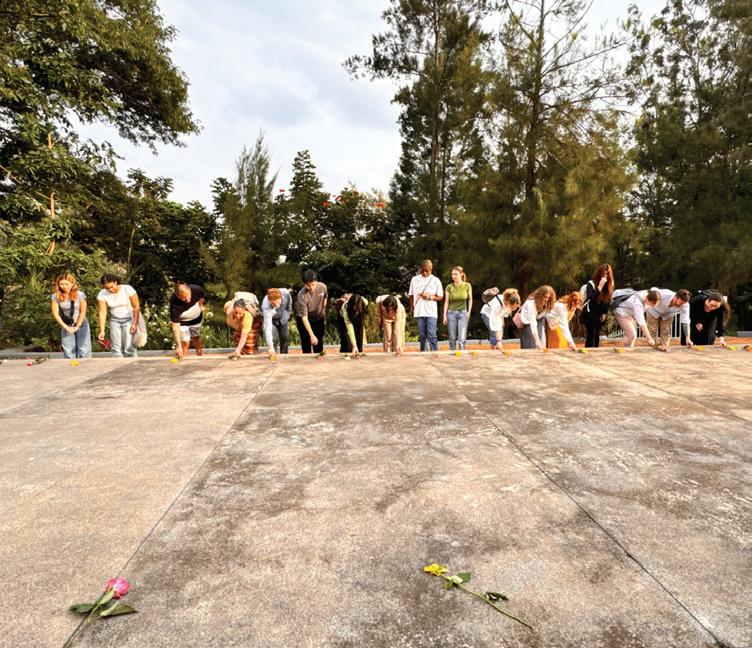
INKWELL: VICTORIA, BRITISH COLOMBIA, CANADA
“I really enjoyed our Sea Plane ride around Victoria. It was a roughly 45 minute panoramic seaplane ride that toured the Victoria area which was incredibly beautiful as it is surrounded by a beautiful and vast ocean.” Lucy Hall - USG Yellow Tie
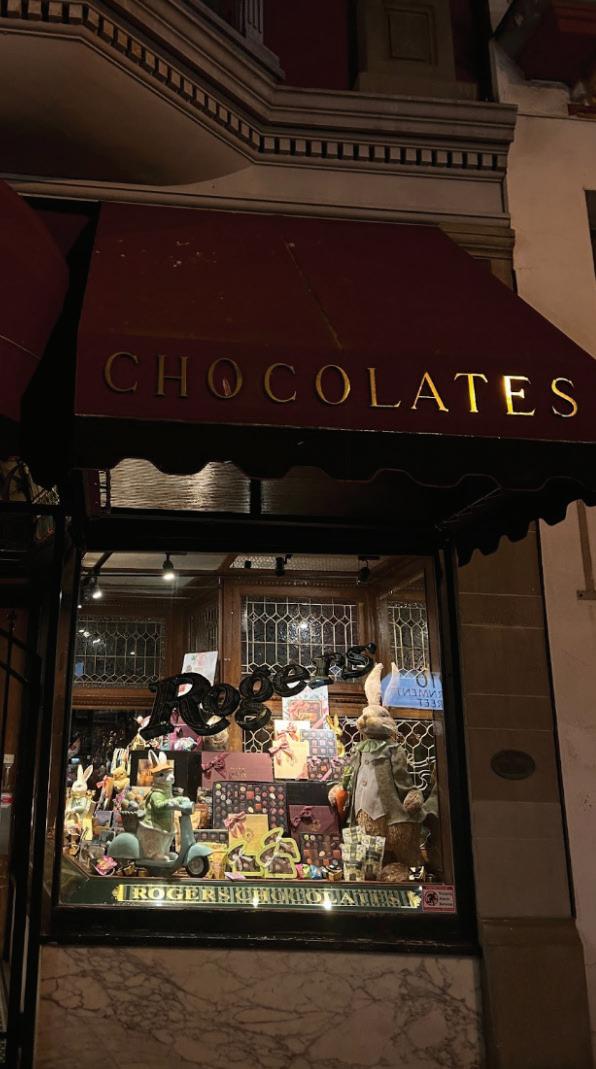
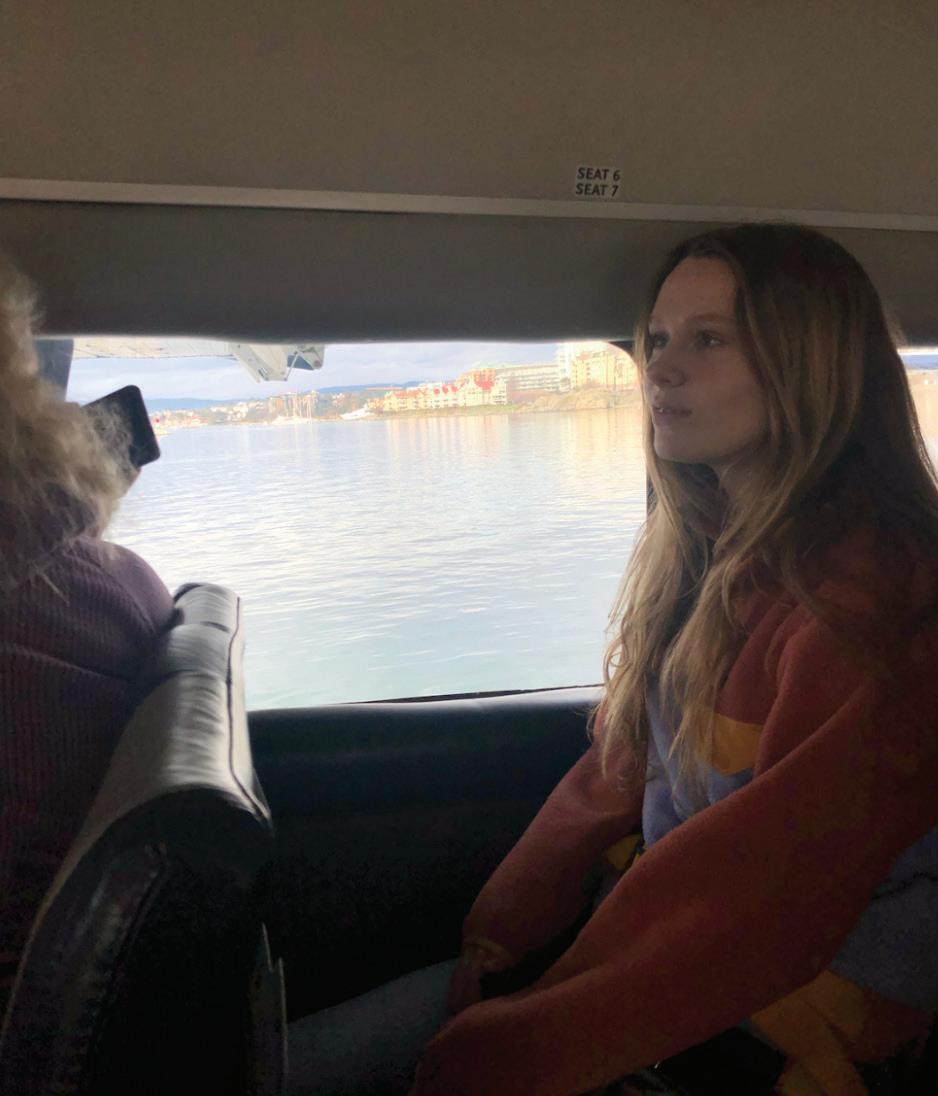
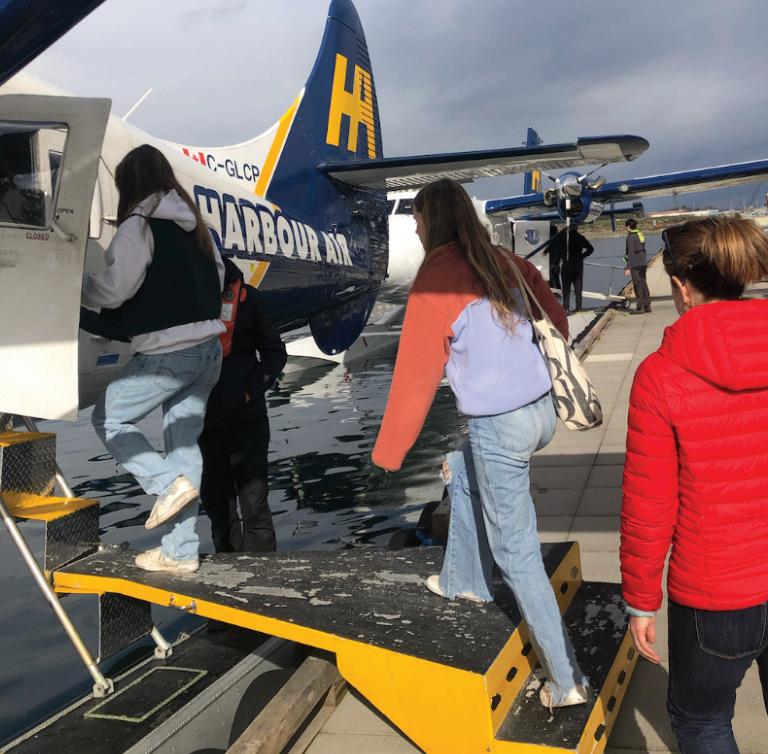
“My favorite moment during the selective trip was when we went to Volcanoes National Park and were able to see the Golden Monkeys. They had taken over some farmland and the monkeys were all around us. They ran through our legs while eating a bunch of potatoes and other things in the soil.” Wilson Dicks - USB Yellow Tie

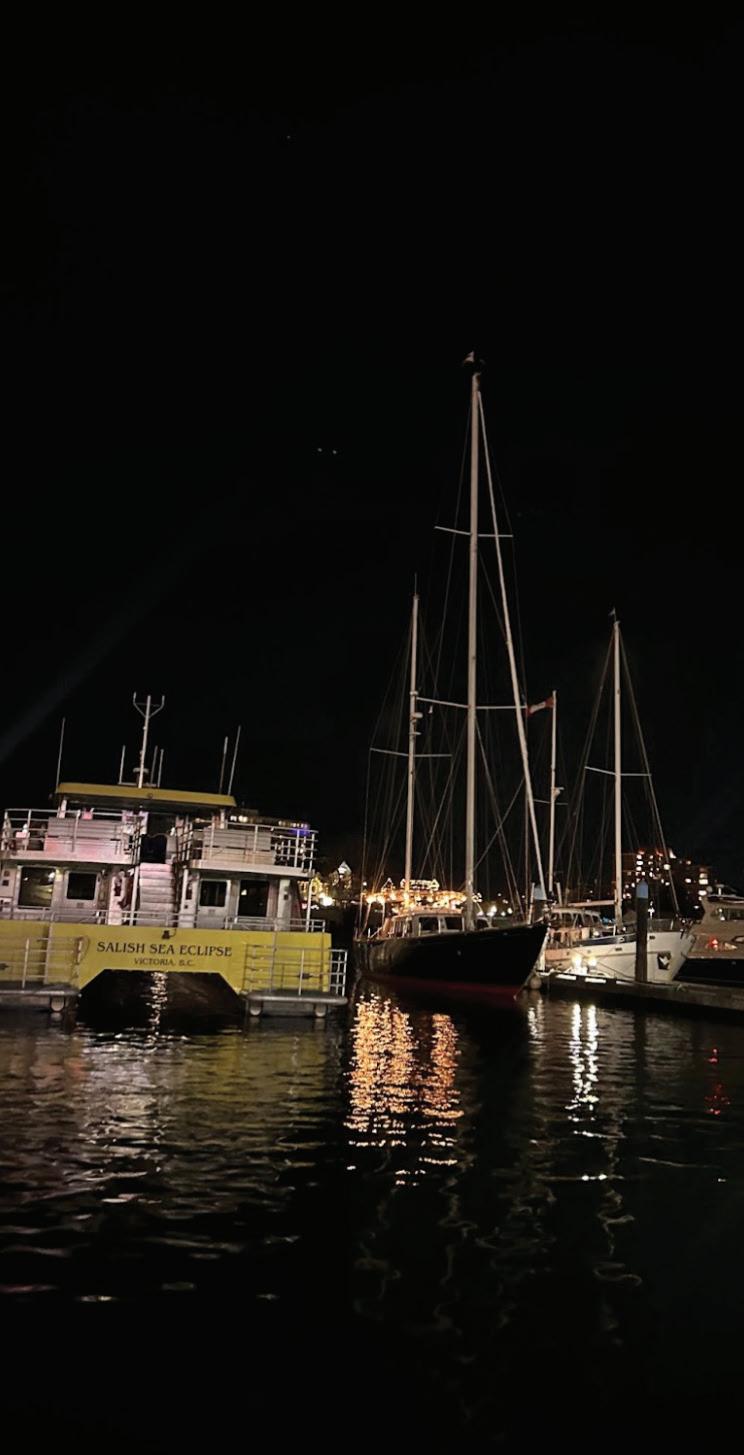
LABS: VANCOUVER, CANADA, CANADA
“I really enjoyed our Sea Plane ride One of my favorite parts of the trip was when we went skiing. We got flagged by ski patrol for yelling random stuff. Good times.” Evan Pham - USB Yellow Tie

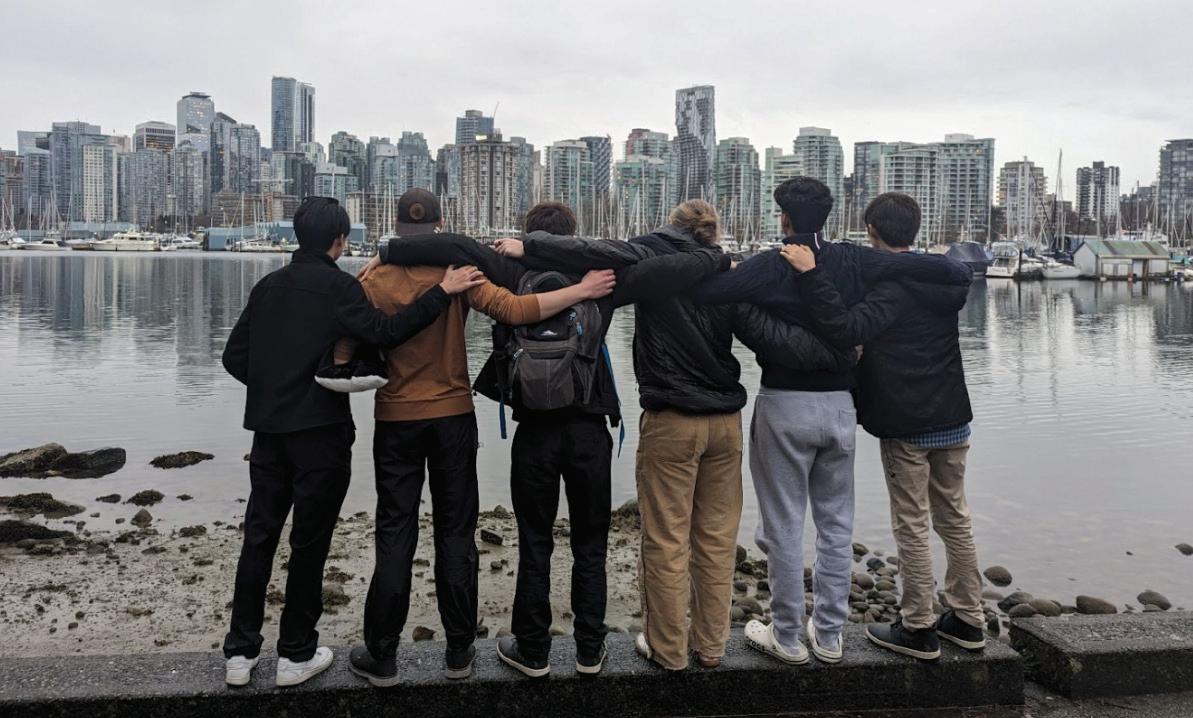
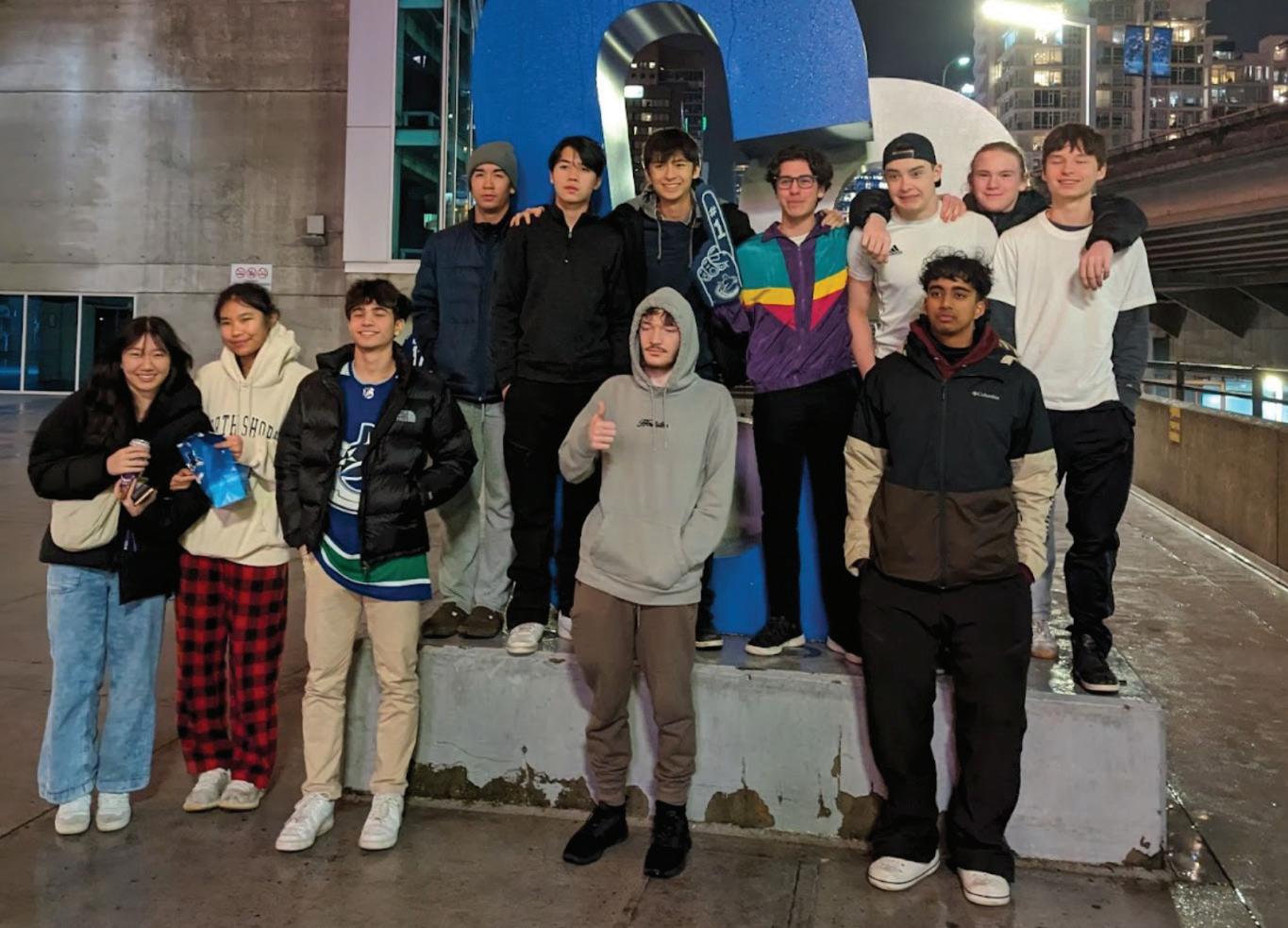
PHOTO CONTEST
